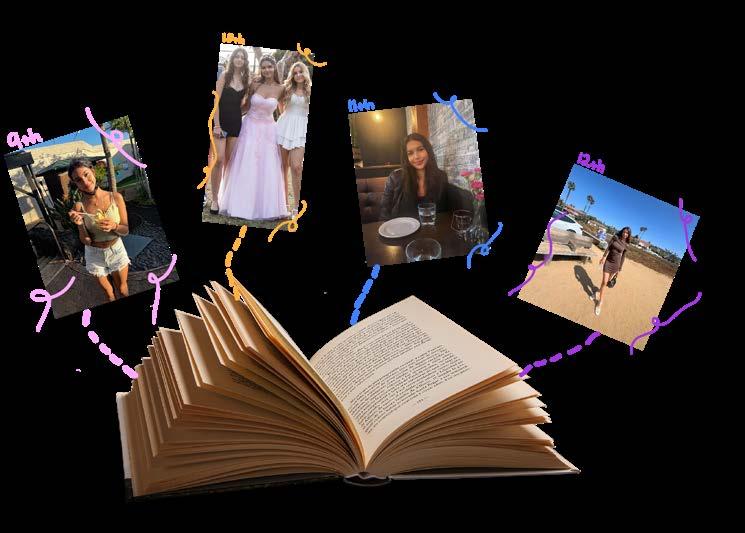ht
We grow up accustomed to the idea of being in a "high school clique," when in reality, there are many parts to one's identity, and often times, we are multifaceted

We grow up accustomed to the idea of being in a "high school clique," when in reality, there are many parts to one's identity, and often times, we are multifaceted
features 7
Senior Rylee Titoni unlocks new creative pathways through embroidery and patchwork opinion 11

Editor Daniella Gross exposes the harmful effects of toxic minerals in everyday period products
sports 15 Redondo dominates Huntington Beach, winning the game 21-0
by Safi Hamilton-Torres
ours before the home football
Hgame against Mira Costa High School, ASB hosted their annual Senior Tailgate after school in the quad with about 400 people attending. This pregame social event celebrated seniors reaching their last year of high school with various games, tropical themes, food and music.
Feeling the “pressure” of senior her

to “take advantage” of this opportunity to “fulfill” her senior year by interacting more
with her peers.
“The fact that many people showed up to Senior Tailgate this year adds to how worthwhile it is to attend these events just for the fun. Everyone dressing up in school spirit for the football games and hanging out adds to the exciting atmosphere surrounding these events,” Funakoshi said.
Senior Jorge Laverde has had
Providing games, food, and music were essential aspects of planning this year’s Senior Tailgate, but ASB School Relations Commissioner, senior Chloe Caywood and other ASB members had to create more ways of getting people to attend.
editors-in-chief
Scarlett Mische
Marley Van Pelt
Stavyah Naveen
Cristina Couch
digital director
Ethan Chi
news editors
by Katarina Sapina
Last school year, AP Precalculus was the only AP class offered zero period. Redondo now offers multiple AP classes zero period, such as AP Psychology and AP English Language and Composition. Senior Noe Fung, who takes zero period AP Psychology, believes taking an early AP is beneficial to her learning. Fung says it “frees up [her] schedule,” while AP Psychology teacher of 15 years, Megan Gould, thinks that, depending on the student, “it could not work out.”
This year, Gould teaches AP Psychology zero period for the first time. Gould advocated for AP Psychology, as well as other APs, to be available at this time. In past years, she has hesitated to teach a zero period, but she still did to “give more students a chance” to take an extra AP class if they previously did not have time.
“Students’ junior and senior years get packed, and they aren’t able to fit it in. So I advocated for it to the social studies department, to Ms. Marcon, and the administration to see if it could happen, and they were willing to try it, and I was willing to try it,” Gould said.
The fact that many people showed up to Senior Tailgate this year adds to how worthwhile it is to attend these events just for the fun.
COCO FUNAKOSHI SENIOR “
his mind “opened” towards participat ing in large social events since attending this year’s Senior Tailgate. According to Laverde, he previously assumed that af ter-school events were boring and wasn't going to give this event a chance unless his friends convinced him to go.
“The tropical theme idea is awesome since it leaves everyone hyped and brings the energy to these football games. It’s something you won't get to experience again, you only get to do this once before you graduate,” Laverde said.
“Creating social media posts and spreading advertisements helps with raising student participation,” Caywood said. “The word eventually gets spread around, especially with these events going along with the football game conveniently after.”
Caywood explains how ASB oriented the “focus” around planning this year's Senior Tailgate by emphasizing that this event is one of the last events to be able to participate in as a senior.
“Seniors start to recognize that this is their last year here, and they’ll notice these upcoming events such as Senior Sunrise, Senior Breakfast and Senior Tailgate,” Caywood said. “They want to get more involved within these school events to make as many memories as they can before they graduate.”
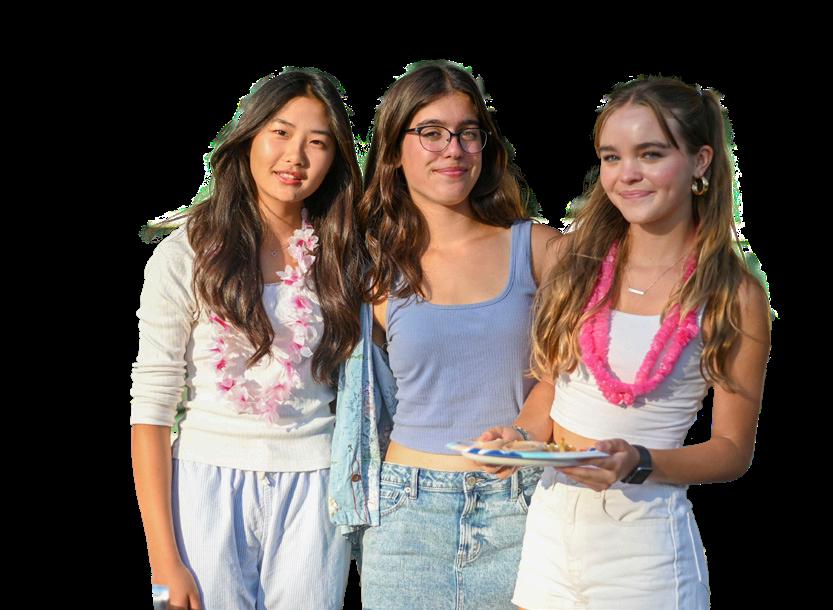
block period, so the classes are shorter but are held more often.
“The best part is that you have the class every day, so it’s consecutive and that way it’s always in your memory,” Fung said. “I feel like I will do about the same in the class, because it has the same content [as a block period], but it will be more fresh in my brain because I’m doing it every single day," Fung said.
Since zero period is only half the duration of a block period, it may lead to more
“Part of the benefit for students and for me is that it’s challenged me to figure out how to organize it in smaller bursts, which for any content-heavy class, I think is really nice,” Gould said. “In block periods, if there were a lot of concepts, you leave and you’re like ‘What just happened?’ so I think the students have liked it. It’s allowed them to not be overwhelmed rather than with the block period lecture.”
Zero period AP teachers need to reformat their tests to fit into a shorter class.

homework and classwork each day.
Junior Kathleen Pham is taking a zero period AP for the second year in a row.
“Last year, I would say test taking was easier because I like doing math in the morning, and I’m more focused, and you can get it over with for the rest of the day,” Pham said.
Zero period is held Tuesday through Friday rather than every other day like a
“The worst part is you have to fit in so much stuff within such a short class period, so it’s a bit more stressful because in your classes you are doing more stuff,” Fung said. “[Test taking] is not that different, but if the test is long we have to take it over two days.”
Gould, however, has learned that she prefers teaching a zero period rather than a block period for AP Psychology, which she considers to be a “very content-heavy class.”
“I’m a little worried about my zero period getting the stamina to sit through the big long tests, particularly for students who have never taken an AP class before. In my class, they are not going to be able to take any tests longer than 60 minutes, and the AP test is longer than that,” Gould said.
With the addition of new zero period AP classes, upperclassmen have greater control over their schedules.
“I’m glad APs are offered for zero period, especially if you are a junior or a senior and taking a lot more AP classes. It allows more variety in your schedule and you can have a free period more easily,” Pham said.
With zero period starting earlier than a normal school day, Gould says that the class would work well for “self-motivated” students. On the other hand, for students who are not morning people, “[she does not] think it would work out.”
“It comes down to the students, and so far they are very eager, motivated, here on time, awake and listening,” Gould said.
Leyla Evenson
Payton Rothluebbers
features editors
Daniella Gross
Ava Anzivino
opinion editors
Claudia Turner
Priya Ramcharan
entertainment editors
Isabella Kohler
Meara Fay
sports editors
Celeste Ernau-Vargas
Jayla Dorbor
writing & copy editors
Kat Otey
Deeksha Prasad
Delilah Aguilar
online editors
Lauren Choy
Rena Felde
Valentina Masoni
Deeksha Prasad
Amina Raïss
Sam Schwartz
Marlena Lipin
Kate Brucia
Katarina Sapina
Aaliyah Roberson
advisor
Kerri Eastham
staff writers
Sanaya Bhatt
Aashka Bhuptani
Fi Borgese
Blaze Braff
Ziva Chabot
Kaitlyn Chang
Evie Comeaux
Bella Engleman
Ellie Gasparovic
Safi Hamilton-Torres
Stella Harper
Carly Jacecko
Kate Lanzdorf
Allison Lee
Kayli Mai
Hayden McMahon
Emery Min
Isabella Nguyen
photographers
Mia Cielak
Lorelai Land
Haylee Lawrence
Kathan Mallya
Talia Pattishall
Evan Teal
Ashley Peterson
Melissa Pilato
Sophie Rebbeck
Khloee Tange
Francisco Ville-
gas
Matthew Vitt
Samantha Kim
by Celeste Ernau-Vargas
Following the introduction of AP Human Geography for incoming freshmen last year, RUHS is now launching Ethnic Studies as a new option in the 9th grade curriculum. Ethnic Studies, offered to all incoming 9th graders, is an alternative to English 9 and English 9 Honors. Beginning next year, all incoming 9th graders will take the class, which will incorporate both the English 9 and English 9 Honors curriculum. The course is “honors embedded,” which means students have the opportunity to earn honors credits if they meet the rubric requirement for the weighted grade.
Freshman Julia Fodelmesi expresses why she chose to take the class instead of English 9 Honors.
“I chose this class because I thought that I would learn a lot more new things than in honors, and I liked the benefit of it being honors embedded because it gives us a chance to get that option if we want it,” Fodelmesi said.
The class has offered its students a new perspective on what an English class can be, exploring immersive vocabulary and a historical perspective of the literature they
“
The point is to center writers from marginalized communities, so we are very intentional of the works we are bringing into our room, and in what ways the stories and authors we are bringing in reflect the people in our room.
JESSICA VARIZ ENGLISH 9 HONORS AND ETHNIC STUDIES TEACHER
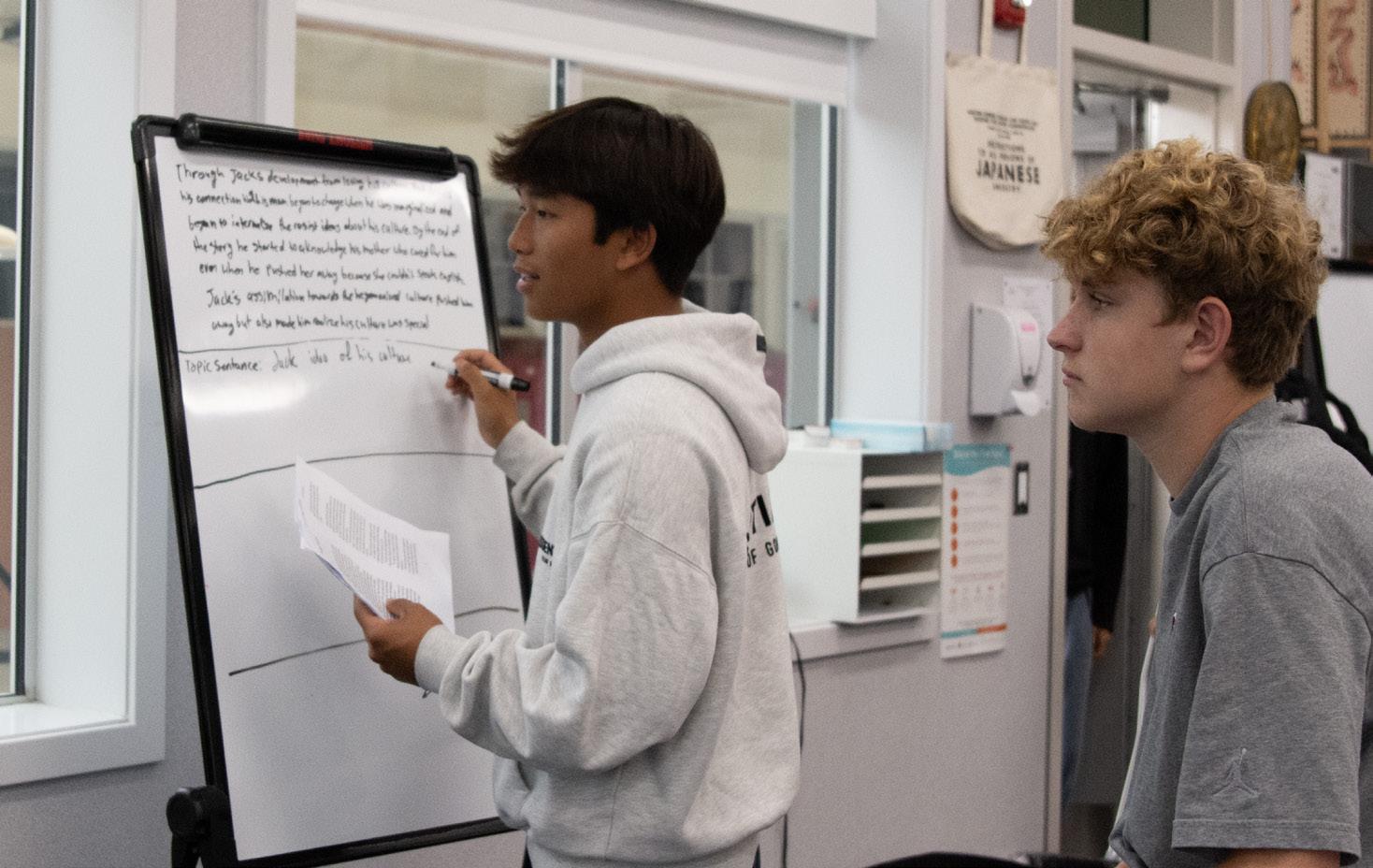
are reading. Freshman De’Syre Miller depicts her experience in Ethnic studies in contrast to other English classes.
“You’re able to discuss different things and not be so focused on essays and writing about one certain thing,” Miller said.
In contrast to most California English classes where the reading list usually consists of classic authors, Ethnic Studies has allowed students a variety of diverse authors who write about overlooked topics. English 9 Honors & Ethnic Studies teacher Jessica Variz notes the importance of the literature that students have the opportunity to read while in the class.
“The point is to center writers from marginalized communities, so we are very intentional of the works we are bringing into our room, and in what ways the stories and authors we are bringing in reflect the people in our room,” Variz said.
and that they are living with. This course is finally reflecting the rich diversity of our community,” Takesue said.
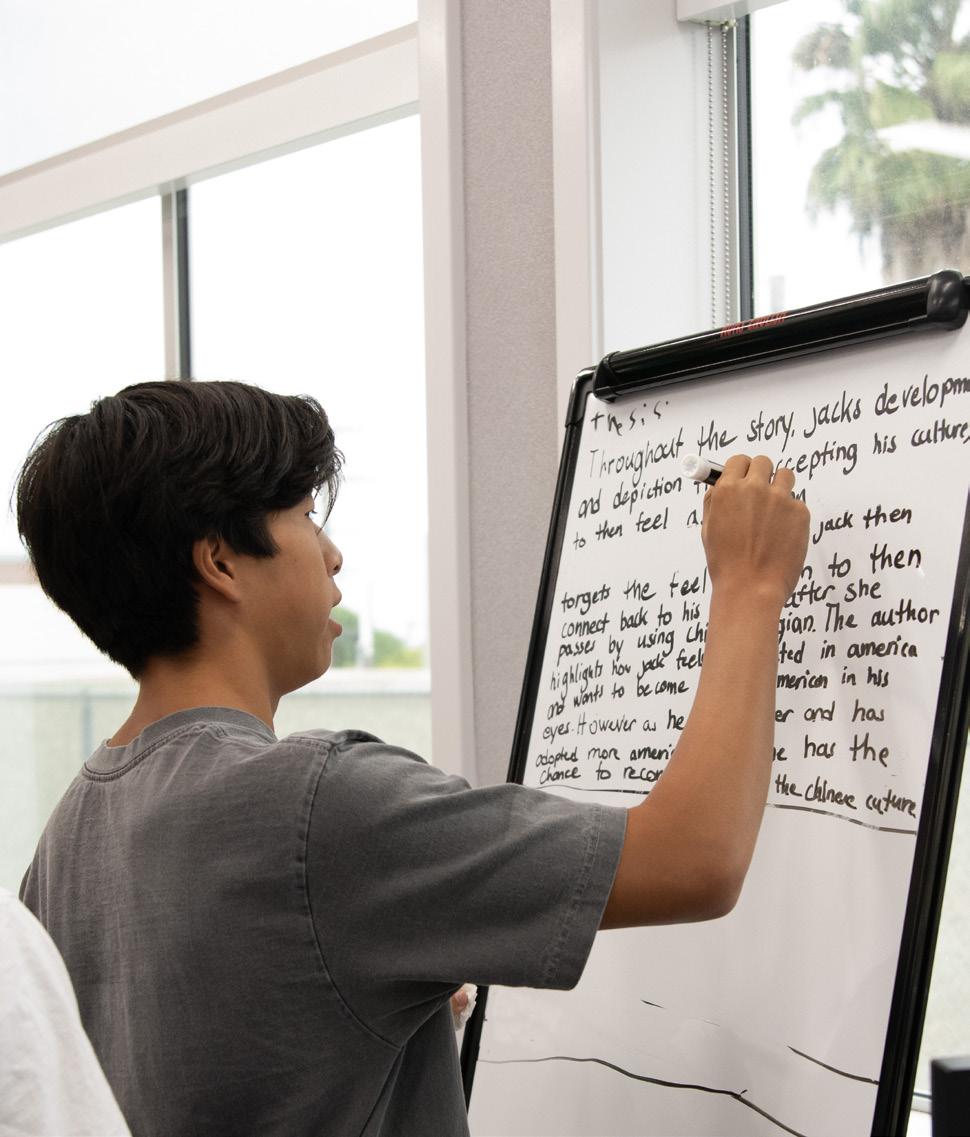
Miller feels that the commonly disregarded topics these authors highlight in their writings is an important aspect to the overall learning environment of the Ethnic Studies class.
“I like being able to have those difficult conversations that regular English classes or honors English classes don’t have. It’s a very open classroom, so I get to experience and learn different perspectives,” Miller said.
AP Literature and Composition and Ethnic Studies teacher Kitaro Takesue, who piloted the course at Santa Monica High School, emphasizes the need for the class at Redondo Union.
“Students have been clamoring for this for as long as I’ve been in this district. They are so excited to read the stories of diverse cultures and groups that they are a part of
The class has also built a safe space for all students as well as a community through learning and respect.
“We did a community circle, where we all brought an item and shared a little bit about ourselves and some highs and lows so far in the school year. We were able to share a side that many people might not see. I liked learning about everyone and to see who’s around me,” Fodelmesi said.
Miller recommends students take the class and learn how to have vulnerable conversations.
“It doesn’t get better than having an open, difficult conversation without feeling judged,” Miller said. “It’s better to be able to talk about those things in life because not everything is an easy conversation.”
discuss
by Isabella Kohler
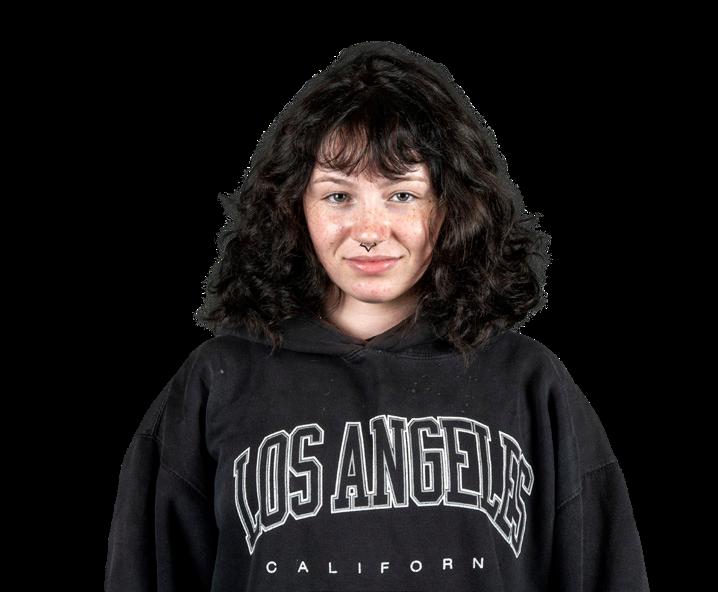
“The name Zaylie has lots of different meanings, but my favorite, told to me by my mom, is special princess. She says it's Australian. I've never met another Zaylie in my life; I genuinely love that it's so one of a kind and unique."
Zaylie Yex, 12

“My name means sunshine, which makes me think of a sunny day and just someone that’s really welcoming, so that inspires me to be a more welcoming and happy person every day. My name also has Spanish roots and I really love that it continues my Spanish heritage because it's really important to be proud of who you are and to honor the people who came before you.”
Solana Hernandez, 12

“I’m Muslim, and in my religion, my name is like ‘a gateway in heaven,’ so my name to me carries my origin. It is also of Arabic origin, and it means ‘care and protection’ so to me, my name resembles protection. Also, because it was given to me by my aunt who passed away, I always feel like I have her guidance with me.”
Inaya Mayet, 12
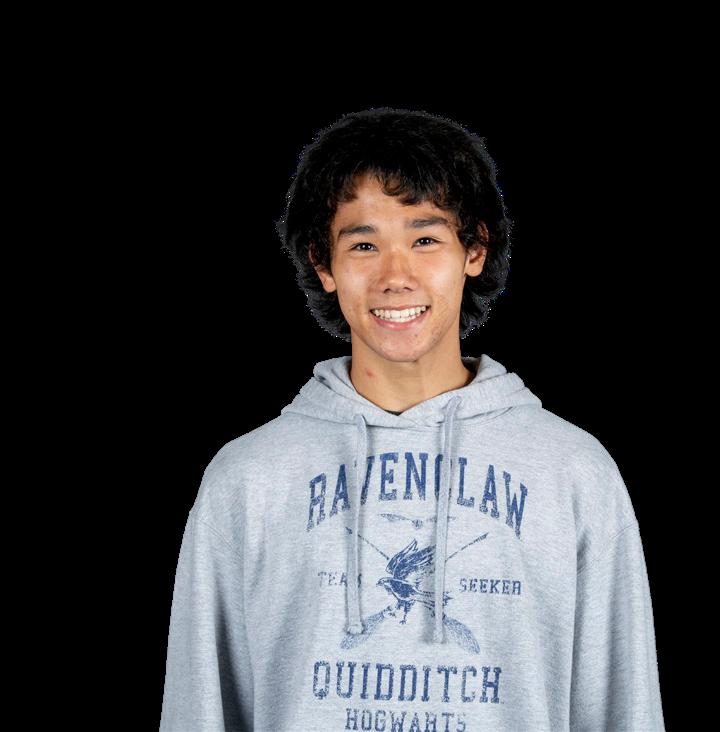
“When people think of the name ‘Titan,’ I think they think it symbolizes strength, but I wouldn’t necessarily say that I’m strong or bold. I am hardworking, though, so I think my name fits me in a way that’s not what people would think, and it’s very unique in that way.”
Titan Morishige, 11
by Sam Schwartz

In a world filled with noise and chaos, “The Light Podcast” features conversations among three Redondo students, centering on how their faith guides them. The podcast speaks about each group member’s favorite and special verses. Junior Ian Son, and seniors Zeke Johnson and Noah Elhardouzi have bonded and turned into better people through the relationships they have deepened with Jesus, and have truly shown that Christianity can bring people closer together when practiced.
“We have that union of Christian faith to be like, [Hey], can you pray for me? Or can we call? Can we talk about our problems? I think just having those Christian friends in my life has just been so much more beneficial for me, and I think us as a group have just bonded and grown so much,” junior and creator of the podcast Ian Son said.
Son was motivated to create the podcast by “personal growth,” and the positive impact of faith.
“I think the main turning point where I felt super inspired to start a podcast was when I first started spreading the gospel, which is when I saw how it was impacting some people and the way it was positively changing their lives,” Son said.
Son may have had the idea of a podcast, but the podcast includes two more co-creators: seniors Zeke Johnson and Noah Elhardouzi. Bringing these two in gave the podcast “some needed personality,” according to Son.
“I think one of the biggest reasons why I'm so glad I brought [Johnson] and [Elhardouzi] to the podcast is because each
of them have so many different experiences and stories to share that their diverse testimonies are going to impact different people. I'm not going to be able to impact someone the same way that they're going to be impacting them. I think it's super important to have different people and different viewpoints,” Son said.
Having different perspectives is also valuable to Elhardouzi, who believes that following Christianity can help people make amends and show others how much Christianity can be a part of someone's life, no matter who they are.
God to add me or invite me to do it with him, so
through my Testimony we could reach other people. People look at Ian, and he's the perfect dude, but Zeke and I have had our ups and downs through high school. I think that Ian was called on for us to be used by God to spread His word and help show people that even though we aren't perfect, we're still followers of God,” Elhardouzi said.
According to Johnson, the three can help represent God's messages, so people can grow closer through the help of the podcast and see role models of a true Christian around the community.

“[We started the podcast] to introduce people to Christianity.
Even if people don't watch it at all, all they have to do
is see that we're doing it, because if they see what we're doing, they’ll know we are Christian. If they know we are Christian, see us around and see how we act, then they'll know that we're representing God. It's good that people know I'm Christian because now if I'm living a certain way, they know you're following God and know this is what it means to follow God. So ideally, the podcast was made to spread the word of God and help people grow in their faith,” Johnson said.
Though the podcast has had a successful start, the group still wants to expand into new ways to reach people, according to Elhardouzi.
“Aside from the podcast, we're working right now to set up some kind of Bible study for Redondo students. We want to create a space for community and for people who are watching the podcast. Also, we're all leaders at the Fellowship of Christian Athletes [FCA] club on campus. We have a few famous guests in the works, so that hopefully will bring in a crowd,” Elhardouzi said.
They know the power of community-building through religion because it has developed the connection among the three of them. Their deep talks about Christianity have strengthened their relationship enough to be friends for life.
“[We now have] an unbreakable bond. [Religion] is the best thing you could have in common because the way you think about life is the exact same way,” Johnson said. “So whenever you have a disagreement, a fight or anything, you guys have Jesus in you.”
by Francisco Villegas
Whether it be through sculpting, painting or sketching, senior Cash Vargas has developed his own unique style. Over the past five years, Vargas has grown his art skills from originally just graffiti and lettering into what is now a part of his identity.
The original interest in graffiti and its style still shows itself in Vargas’s art, with a similar level of expressiveness and vibrancy to popular graffiti, but with his own twist. Vargas is able to find this enthusiasm that pops in his art by channeling his emo tions.
“When I'm feeling a certain way, I just want to put pen to paper and try to make something out of it,” Vargas said.“I've been able to create things I re ally enjoy. From my sketch books that are just full of the same style of pieces, which I have a lot of, to my sculptures that I find really cool. I like doing faces and head sculptures, those are what I've been making and they're my favorite right now.”
According to Vargas, he wasn't al ways able to take what he feels and push it out into his art because, before, he dealt with mental blocks that limited him. At times, he used to rely on reference pictures, but has since developed into not needing them as much and is able to express his own style. He enjoys this feeling more than using ref erences because it is more “free.”
“I've gotten better over time. Even
when I do suffer from cre ative blocks, there's so many mediums that I can work with. So, I always have different choices to express myself with and I, luckily, can go to whichever one that flows creatively. With clay, I can always sit and sculpt faces and then with pens and mark

blocks,” Vargas said. Ceramics teacher Toni Artiga has had two classes with Vargas where she has seen him develop his style even more. She notes his ability to freeform his art while still going above and beyond the expectations of the class.
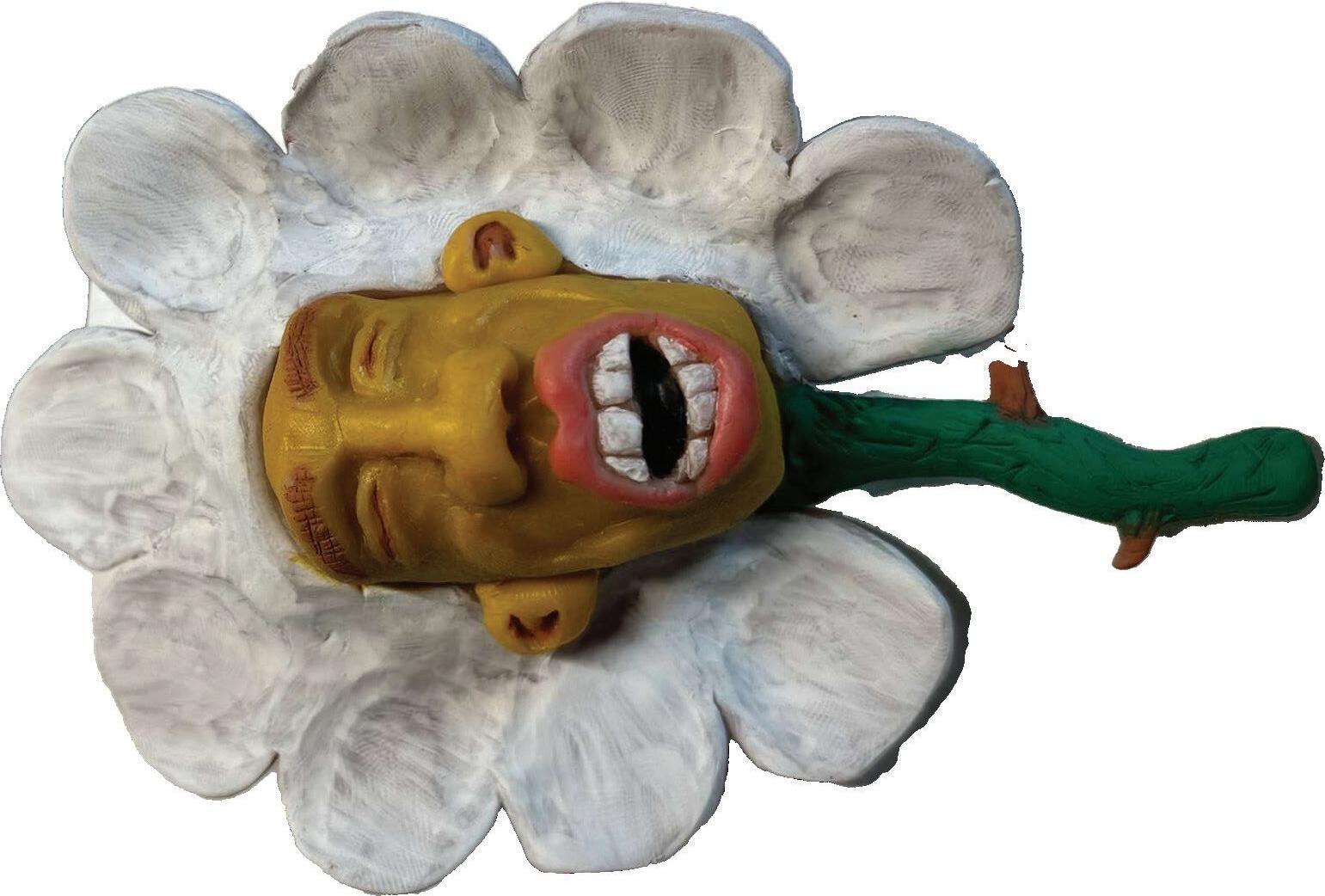
“I saw such a high level of skill from him [in his first year].

His sculptures are very highly detailed, which set him apart from other students because of his vision, and it's impressive because he doesn't even need resources. He can just do it from memory, a skill that's not developed very much with some other students. I can see that he'll exceling even more at that this year,” Artiga said. “He works all the way to the end, he never is not working. You can really tell he enjoys it, and that really sets him apart from others who [take art classes] because they have to be there. You can see it's really a passion from that effort that is in his art.” Vargas looks to take the next step with his art, incorporating it into his future plans. Vargas has already made sales of his art pieces to many people, including Mrs. Artiga, but now wants to sell shirts and is considering even minoring in art in college. To reach that point, Vargas has one simple pointer that he's followed.
“I'd advise anyone to practice every single day,” Vargas said. “If you don't think you're good, you definitely can get there if you sit and practice your own style, practice the same thing. If you're practicing every single day, then you're 100% going to get better. It's the only way.”
by Sanaya Bhatt
In the heart of Hawaii's international paddling competition, two 14-yearolds from Redondo Beach made a mark. Representing California, freshmen Georgia Hughes and Daelen Purohit secured fifth and fourth places in their respective competitions on Aug. 31 and Sept. 1, both showcasing their paddling skills in an 18-mile race against top competitors from around the world.
“Placing in the competition was truly such an incredible experience. It really felt like something we had all worked for and worked together on, and to be able to see our months of hard work reflected in how well we did was so rewarding,” Purohit said.
Tryouts took place months before the competition. Once they were conducted, practices began as a team, which differed from Hughes’ and Purohit’s typical practices and included “new drills and training” in order to better prepare the team for the competition.
“We practiced for four months before the race,” Purohit said. “We built a power team of the best [paddlers] in Southern California. At practice, we’d normally have two to three canoes on the water, and our coach would build teams based on who was there. We’d also do a lot of sprints and specific drills, and for this specific race, we had additional practices as well as our usual ones.”
The multitude of drills their group participated in, as well as various other preparations, such as sprints and extended practices, helped set them up for success in their extensive race. Groups from all around the world were competing, and the scale of the competition helped make the race “a memorable and shaping experience.”
“It was the largest canoe race in the world, and there were two races, which were a long course and a short course. For
the long course, there were a total of 300 canoes from multiple countries and regions, and I was really excited to be able to partake in such a big event.”
Not only did the race require much physical preparation, but it was also mentally draining both before and during the
did training with water packs on our backs that got really strenuous. We’d have 20 sprints to do at every practice,” Purohit said. “And during the race itself, you have to have enough adrenaline and energy, and you also have to make sure that you’re helping maintain the energy of the group too.”


actual competition.
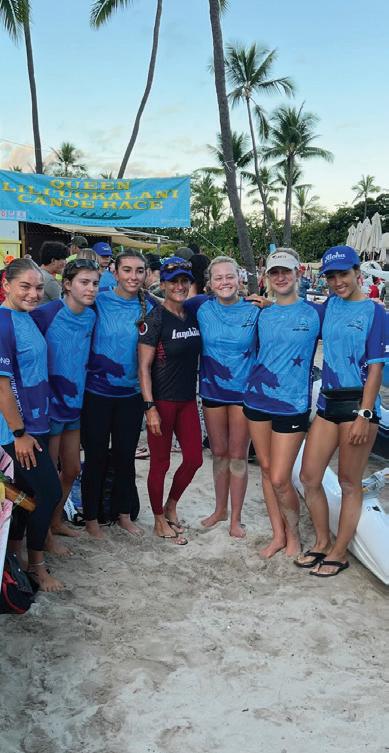
“I actually thought the practices were a lot more mentally challenging than the race. They lasted a lot longer, and we also
Beyond the actual race, the group got to enjoy the many aspects of the competition taking place on the beautiful Big Island of Hawaii.
“A big advantage for me was how beautiful it was. In Redondo, it’s pretty, but it’s usually pretty foggy. During the race, we hugged the coast the entire time and the water was practically electric blue. All you could see was the Hawaiian coastline, and it was also nice to have physical images of tracking out progress. On the other hand, though, it was so hot. It was maybe 90 degrees, and the humidity was at least 80% too.”
Purohit also shared how the calmer water proved to be an advantage, explaining that, “the waves were a lot smaller there, so we didn’t have to worry too much about flipping or having to battle rough waves.”Paddling is an extremely group oriented sport, and teamwork and communication play an especially important role in ensuring the success of the group. Not only from a physical standpoint, but also from a mental one, according to Hughes.
“I’d say teamwork plays the largest role. You have to make sure you’re doing the right things as an individual, but it’s also about taking all of that and making it contribute to your team. Everyone has to be in sync and willing to put in their 100 percent, and that’s how we make sure that we’ll do well,” Hughes said. “Another big thing to remember is what you can do additionally that will support the rest of the crew, like talking in the canoe, or affirming others, or calling changes. It’s a lot easier to paddle when everyone is working together.”
Team bonding between the groups took place both on and off the water; as they practiced paddling in sync, they also found a way to turn their 18-mile journey into a fun, uniting experience.
“My favorite memory of the trip happened during the competition. We somehow convinced our coach to let us bring a speaker on the boat. We got through maybe an hour and half of the race without it, so most. But we noticed that the energy in the boat started to dip around after that 90 minute mark, so we turned on the music,” Hughes said. “We had such a good playlist, and the whole boat was singing and having such a good time, and it really brought up everyone’s energy. Overall, this trip was incredible, and we’re so lucky to have been able to compete.”
by Kayli Mai
With a chilly plunge into the salty water, a 12-foot-long stock board, and a look of determination, Junior Finley Murphy slung her body over her board to commence Catalina's 47th annual Classic Paddleboard Race. Murphy’s training, which consisted of 10-plus mile paddles, canoeing, and water polo will be tested during this 32-mile race, spanning Catalina to the Manhattan pier. For the next six hours and 14 minutes, Murphy paddled her way to placing third, making her the youngest girl who’s ever competed. Throughout the race, Murphy always kept her head up and in the game.
“There was never a point where I wanted to quit or where I doubted myself. The first, 17 miles, three-ish plus hours, I was paddling alongside one of my friends, so that was super helpful, but I never ever wanted to quit,” Murphy said.
Finley Murphy has a line of relatives
I'm so small, in the grand scheme of things, this problem I have is so small compared to the world, and it's nice to feel a part of something bigger,” Murphy said.
More than just for a sport, the water had always been a part of Murphy’s life, before she was even born. She explains how “[her] father got [her] house specifically so he could have access to the
“
If I'm ever having a big problem, and go in the ocean, [when I] open [my] eyes underwater and look out at the horizon, [I] think, wow. I'm so small, in the grand scheme of things, this problem I have is so small compared to the world, and it's nice to feel a part of something bigger
stayed. Watching her grow up and watching her paddle, Catalina was indicative of that. I'm not sure she would have done that if she was living somewhere else,” Mike Murphy said.
While watching his daughter participate in various water-based activities, not only was Mike Murphy proud of her, but he was also able to admire her resilience. Something that he learned from watching her race was the “value of resilience and mental toughness, and what people can accomplish when they set.” While cheering her on, Mike Murphy remembers seeing the nation” written on his daughter’s face
her start, in part because I was excited for her, in part because I was worried, she's a small kid. I was concerned, but I also was confident that she could finish. As the race developed, I was more shocked at how well she was doing, paddling right up alongside the people who went on to win the race. The whole time she was paddling, it made me think a lot about all the people that have been a part of her life from the time she was born, who have been great role models [who are] very supportive and always encouraging,” Mike Murphy said. Murphy paddled and used her “competitive nature” to remain focused on her goal of placing. To Murphy, although she did want to win, and was aiming to, she mentions how her fellow competitors weren’t just “out for blood” but instead a supporting factor.
“When you're racing, it takes the edge off when you see the person next to you, listening, bopping to the music and just throwing a thumbs up,” Murphy said. “The paddling community in America, it's pretty small, but everyone's super close, and super supportive of each other.”
lutely amazed. I gotta say, I was a little teary-eyed watching

After finishing the race, Murphy reflects on the experience and grows excited to compete in next year’s. To her, the ocean isn’t just for paddling, water isn’t just for water polo, but is something more, a guiding force. From childhood, Murphy has always viewed the ocean as an anchor in her life.
“It's always felt very safe and consistent,” Murphy said. “No matter what's going on in the world, you'll always have the ocean.”
Marvin Brown joins the RUHS family as the school's newest proud principal
by Priya Ramcharan
In hiring RUHS’s new principal Marvin Brown, the Redondo Beach Unified School District consulted the Education Council, students, parents and staff. Brown checked every box throughout the process. Not only is he armed with experience in special education and earlier age schooling, but his values directly align with the school.
“For Mr. Brown, being a principal is more than a career, it’s a lifestyle and a calling,” Superintendent Dr.Nicole Wesley said.
Brown was born and raised in Colorado and served as an educator at all levels in the RBUSD district.
“Working in all levels of education, I got to see the development of students over time, from elementary school, to seniors heading off to college. I find that no matter the age or the school, students have goals for themselves and a desire to achieve,” Brown said.
However, Brown sees high school as more than just rapid achievement. He draws upon his own high school experience to lead, remembering not only the academics but the experience itself: athletics, friendships, and specifically his formative teachers.
“School is more than just what you learn from a book. It’s about the experience you have,” Brown said.
Brown is also inspired by his brother who has down syndrome, which creates a “soft spot” for special education in the classroom. He is proud of the co-teach classes and accessibility that is a part of RUHS. Brown remembers watching his mom, who was also an educator, raise his brother and him. He grew to appreciate his mom’s struggles raising a special needs child, and it shaped his values such as patience and “always giving kids second and third chances.”
“I learned a lot from her. She really in-
fluenced my leadership style as an educator,” Brown said.
Despite chances, however, students only get four years at RUHS. Brown encourages them to make the most of it.
“I’d challenge kids this year to get out of their comfort zones. When you get off cam pus, meet people from other schools, get out of your bubble. That’s when you grow and mature and learn something,” Brown said.
to study and play D1 football at North western University in Chicago. There, he was introduced to a new culture and community.
new experience,” Brown said. “When I was 19, I did internships that helped me grow. Working as a caddy on a golf course really affected me because I got to meet CEOs and vice pres idents of compa nies. That kind of communi cation ex perience really helped me in my role as princi-
pal.”
With these experiences, students can reach success at RUHS. Brown defines success as an “attitude.”
“I want kids to find their purpose and their passion and to enjoy themselves in a
dent-athlete, the value of being involved in something,” Wesley said.
As his mother taught him, Brown believes in second chances and service-oriented leadership. He applies those values to the disciplinary aspects of the job as well.

“I look at my job as a service job. I am not here to dictate. All students want a school that has high expectations for them and structure, and they really thrive in those environments. When you’re a teenager, it’s hard to know the guardrails and the boundaries. When adults set boundaries, then kids can just head straight down a path,” Brown said.
Brown applies these values to the disciplinary aspects of the job as well.
“If somebody gets in trouble, we have to discipline them. We think of it as a way of helping them make better decisions rather than just something punitive,” Brown said.
In terms of student-led change, Brown is very excited for the ethnic studies and AP African American History programs to reach students.
“It’s phenomenal. I love that our students are learning about more cultures. That’s what makes the United States of America great. All the different religions and cultures and ethnicities and races that we all identify with and learning about it together. I never had that opportunity in my own high school, so visiting classes and seeing the energy and enthusiasm is outstanding,” Brown said.
Mr. Lewis led a group of students to Australia and New Zealand, as well as a group to Costa Rica and Panama over the summer
Going on a trip to a foreign country with your biology teacher might seem like something straight out of Ms. Frizzle’s Magic School Bus, but that was the reality for a select group of students this summer, who returned with new outlooks on life derived from the experience Sophomore Chloe de Villiers, who went to Australia and New Zealand, learned to become “comfortable with the uncomfortable.”
“A big part of traveling is the thrill of the unexpected and allowing you to learn how to adapt and go with the flow. That’s something I personally struggled with,” de
he led one trip to Australia and New Zealand and one to Costa Rica and Panama. While the trips do focus on science and culture, much of the students’ learning is really learning about themselves and what they are capable of.
“I think students really just learn a lot about themselves when they push themselves,” Lewis said. “I actually did a lot of my master’s research on the trips, and I found that the number one thing that students get on these trips is confidence to be themselves and confidence to try new things.”
Everyone on the trips challenged
by Kate Brucia,
relationships with their fellow travelers. This bonding starts before they even board the plane, as Lewis planned various activities for the groups to break the ice before the trip. One of his favorite activities was the potluck and presentation night, where each person researched a topic related to


the location.
“I realized when I started planning these trips that I want to infuse my personality into them and to make them something that’s not just a trip abroad, but an experience that can shape your life. I know for me, when I was in high school, I would have been quite anxious to travel abroad with my peers, no parents and nobody I really knew. I wanted to make it more accessible, so that’s why I started doing these pre-trip get-together activities where kids can get to know one another, get to know more about the country that we’re traveling to, and just gain this familiarity with being out of their comfort zone,” Lewis said. “To me, it’s our first opportunity to really start feeling like a family, which is only going to grow more and more on the trip.”
ers will likely never forget. The excursions included snorkeling in the Great Barrier Reef, seeing an opera at the Sydney Opera House, whitewater rafting, zip lining, and so much more. Students were able to see new parts of the world and appreciate “how beautiful nature is,” according to sophomore Sophie Greif, who went on the Costa Rica and Panama trip.

“[I was surprised by] the impact that the trip had on me, because I feel like it gave me a different mindset in everyday life that I wasn’t expecting,” Grief said. “We learned about nature a lot, and it just felt more deep than everyday activities, like going to the mall. Obviously that’s fun, but going to this different place and looking at nature was just so much more fulfilling. ” At the end of the day, this realization is exactly what Lewis hopes students get out of these trips.
“A lot of kids grew up here, in California, which is amazing, and it offers so much, but we’re in this concrete jungle. We’re surrounded by media, and sometimes it’s hard to understand what the actual natural world really looks like, and what else is out there; the different cultures and opportunities you have outside of L.A.,” Lewis said. “For a kid to be out of the country, seeing and experiencing the world helps them realize the natural beauty of Earth.“
The biggest bonding factor, though, was the shared experiences that the travel-
by Meara Fay
Stitch. Hook. Stitch. Senior Rylee Titoni wasn’t looking for a new hobby when she first tried embroidery—she was just bored. Titoni never expected she’d fall in love with embroidery.
"On Christmas break last year, my little sister and my grandma were doing embroidery, but I wasn’t interested," Titoni said. "But then it started raining, so I was stuck inside. I ended up asking my sister to teach me how to put a heart on my shirt, and after she taught me, I did it the entire rest of the day because I thought it was so fun."
That first stitched heart on her shirt opened the door to a creative spark she hadn’t expected. Her confi grew as she saw what she could achieve with just a needle and thread.
"I [thought], ‘Okay, if I can make a heart, then I can make shapes," Titoni said. "So I copied a design of Milo from the band ‘Descendents’ on a shirt and [I thought], ‘Whoa. I just made this image that I see on the internet and put it on clothing.’"
The thrill of seeing a familiar design come to life on fabric only fueled her desire to keep experimenting. Titoni always enjoyed art, but embroi dery brought her inspiration to new heights.
“I did Art 1 sophomore year, and that was probably one of my favorite classes ever. But I feel like since I started embroi dering, I’m more inspired," Titoni said. "All of a sudden, I want to do photogra phy, I want to make an art journal and a collage."
This surge of creativity, according to Titoni, was directly tied to her work with
embroidery.
“Since I started embroidering, I began understanding the importance of that creative side [of myself], because the more creative I am, the more ideas I have,” Titoni said.
“Embroidery was my kickstarter. It was just like

Titoni said. "I told my parents, and since they’re the nicest peo ple ever, on Valentine’s Day they bought me an embroidery ma chine. I was in dis belief. It was so cool."

Embroidery
was my kickstarter. It was just like this creative energy pulsating through my veins.
RYLEE TITONI SENIOR “
this creative energy pulsating through my veins.”
As her designs became more ambitious, she encountered new challenges. Intricate embroideries required painstaking precision when done by hand, and the process became frustrating at times. Her parents, recognizing her growing passion, wanted to help ease her
"I started realizing that certain designs were super complicated and doing them by hand took a long time and was frustrating,"

The new machine made some aspects of embroidery easier, allow ing her to focus more on the creative process rather than the technical limitations of hand-stitching. While the machine made things faster, Titoni didn’t see it as a shortcut. For her, the real art still lay in the design and the ideas behind each piece.
"The machine is just the middleman between the actual product and the art, because it's not that complicated to upload a picture and press a button," Titoni said. "But that doesn’t beat the fun part, which is making the art."
Part of what makes embroidery so special to Titoni is the way it allows her to connect with her friends. She often collaborates with them, creating custom designs based on their interests or big moments in their lives. Each piece is unique, and she enjoys the process of bringing their ideas to life in a way that feels personal and meaningful.
Senior Delanie Corcoran, Titoni’s friend, employed Titoni to create her a sweatshirt after committing to Washington State University last year.
“I was looking online for sweatshirts, because I had to post my [commitment announcement] on Instagram,” Corcoran said. “So [Rylee] said, ‘Well, I can make one
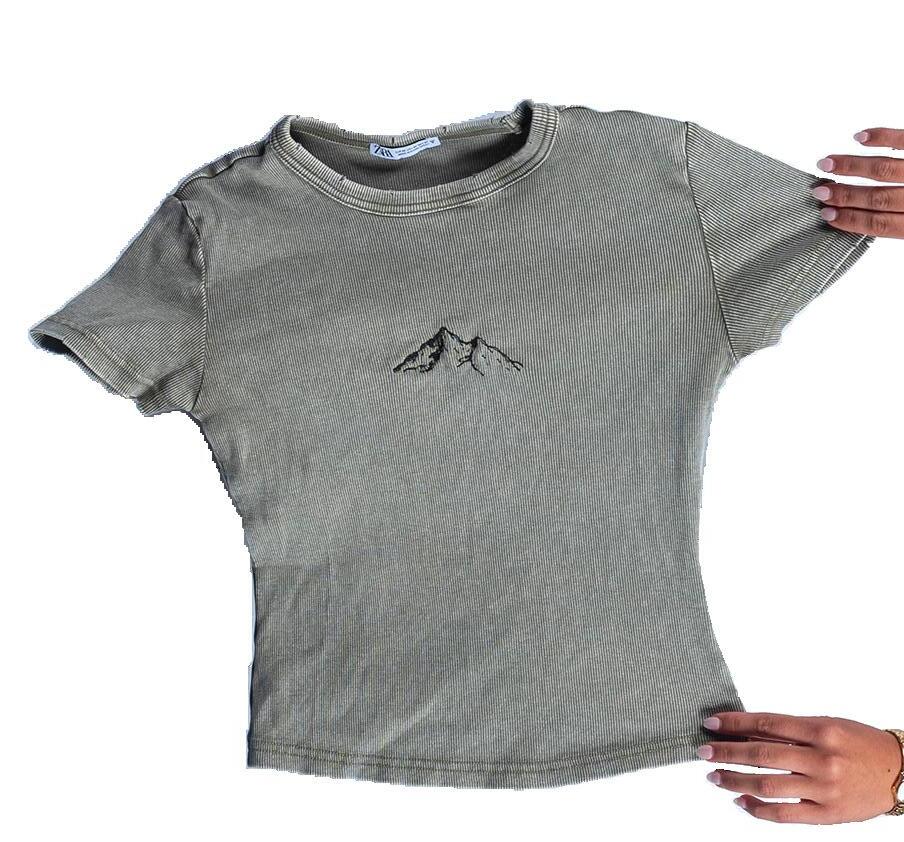
for you.’
And she did, and I loved it."
What made it special for Corcoran wasn’t just the design, but the care Titoni put into making it. This attention to detail is part of what sets Titoni’s embroidery apart, tailoring the designs to their personality and interests.
Currently, Titoni is enrolled in a 3D Design class at SCROC [Southern California Regional Occupational Center] in which she will learn how to make websites to sell the items she makes, and according to Titoni, turning her passion into a business is “in the works.” Overall, embroidery is just the beginning for Titoni, who has hopes of expanding her designs.
"My goal is to be able to use this tool and be more creative in more intricate ways," Titoni said. “Right now, it's only shirts, but maybe it will turn into something else, like bags or other things. I want this really fun and interesting tool to be able to expand and take me down all these paths with all the different things I can do with it."
Audrey Zeigler spent her summer engaging in space and science
Playing basketball underwater was the last thing sophomore Audrey Zeigler expected her summer to include. On Mars setups at the U.S. Space and Rocket Center in Huntsville, Alabama, Zeigler participated in the advanced Space Academy program. Zeigler joined fellow science enthusiasts, ages 8 to 18, to engage in various programs, such as space and science-related lessons, challenges, and missions that simulate mission control and astronaut experiences.
one was doing the same job every time and something was always new.
“[NASA] had this big room of model ships that you go in and you do your mission in,” Zeigler said. “Some people would be astronauts, some people would be Mission Control.”

“My favorite [simulation] was when I was on the Canadarm [Canada’s 17-meter-long robotic arm on the International Space Station], and I was fixing a satellite,” Zeigler said. “On another, I was supposed to be a botanist on the Mars base.”
Sometimes, the missions wouldn’t go as planned for Zeigler and her team.
Zeigler’s father, Charles Zeigler, also went to the U.S. Space and Rocket Center Center when he was around

“We had only had an hour of training before the mission, so trying to actually do everything that I had to do was stressful because I felt like I didn't have enough training,” Zeigler said.
Even so, the missions were still engaging and enjoyable for Zeigler. The tasks and positions rotated every mission, so no
her age, which is the reason why he wanted her to go.
“I thought it would be something she would enjoy because she's interested in space and aeronautics and engineering. She was interested, and so I was supportive in sending her,” Charles Zeigler said.
According to Charles Zeigler, space and STEM has been a long growing interest for
his daughter.
by Leyla Evenson
“Audrey has been exposed to a lot of people in aerospace, military, government and STEM-related positions, so it's been something she's been around for quite a lot,” Charles Zeigler said. “As a parent, I'm proud to see her making decisions for herself. I'd obviously be supportive of her doing anything, as long as it's good and productive, but in that [area] specifically, I think it's really productive. It's a tough field, but it's something that she enjoys and she's good at it, which is really cool to see.
Scuba diving particularly piqued Zeigler's intrigue because, on top of simulating what it feels like to be on the International Space Station, they did scuba diving as underwater training similar to how astronauts train to go into space.
“It’s [purpose] was to stimulate the zero-G [zero gravity]. I'd never done scuba diving before, and it was a new experience. I was kind of scared to do it at first because I was afraid I wasn't going to be able to equalize my ears [to alleviate the water pressure], but once I got down there, we did a bunch of activities with building materials and playing basketball underwater,” Zeigler said.
Aside from the scuba and space suits, the camp also consisted of lessons about different kinds of elements in space and light waves. By the end of her one-week stay at the NASA camp, Zeigler took on many different experiences: she’d seen what Mars looks like, been in a space suit, been tasked with fixing a satellite and had an underwater mission, to name a few . Developing personal relationships was something that Audrey Zeigler agrees was helpful to her, as she was able to meet others who had interests similar to her own.
The experience opened many doors for Zeigler and “solidified” the main interests she had previously gravitated toward, according to Charles Zeigler.
“The social aspect of meeting other people with similar interests was good for me to see,” Charles Zeigler said. “She is starting to understand that there's a lot of diversity in the field, and a lot of other people that come from all different walks of life, all different parts of the country and the world, that have similar interests in science and technology, engineering and math, that are looking at using that foundation for doing good things in their career, and good things for the world.”

In an era dominated by digital connectivity, young adults increasingly explore and form their identities through the lens of social media platforms. The complex interplay between real and digital identities has become a central aspect of teenage development, as exemplified by high school senior Malia Ujiki and her peers.
On a brightly lit Los Angeles night, Ujiki positions herself against the city skyline, gesturing to her friend to capture the perfect snapshot. This is a common occurrence for Ujiki and her friend group, who love to extensively document their outings in carefully planned photoshoots.
“We actually map out the spots we’re going to take photos at,” Ujiki said. “We'll go through them when we're done with our day, and choose the 3-4 best ones out of a group of about 100. I think of it as a way of documenting my favorite experiences through [an artistic] lens. The trick is to make them look candid, even though they’re obviously not.”
This “enhanced version” of real life is an idea that could be used to describe most student’s Instagram profiles, chock full of pictures from dances, dates, and family vacations: the highlight reel of the average
a scrapbook,” Ujiki said. “When I notice I've been repeating outfits, I can look there for inspiration. It’s also nice to have a place to gather inspiration from other creators, and I feel like social media in general has helped my experimentation.”
When posting publicly on sites, which have a commenting feature built in like Pinterest, TikTok and Instagram, it is expected that one will have to deal with trolling and hate comments, especially if a post does well and is boosted by the algorithm.
In Ujiki’s case, she’s been free from these types of comments for the most part, albeit still having to deal with the occasional opinionated critic, which she’s learned to “brush off” with ease.
“Everybody has their own style and if people don’t like it, that’s their business, and they can keep scrolling,” Ujiki said. “I don't really feel ashamed about anything I post, even the most random ‘aesthetic’ pictures, because it’s my account that’s authentic to me and what I love. ”
This positive mindset surrounding social media and the feedback it provides teenagers isn’t so uncommon, despite what worried parents may jump to assume. A 2022 Pew Research Center study on teens and their interactions with the internet disproved the theory that social media does harm to kids, actually finding a link that showed, for a majority of teens, social media had a more helpful than harmful effect. Professional counselor and RUHS alumni Rachel Andrews agrees with these findings, to an extent, noting that, as adolescents develop and explore their identity and interests, social media can provide a much

needed “safe place for kids to find themselves.”
“It’s very normal at this age to ask yourself ‘Who am I really?’ so it makes perfect sense that kids would want to wear different hats and try different things out using online personas,” Andrews said. “We have so many LGBTQ students that don't find acceptance at home, so they create an identity online that can become a source of comfort and safety to them. But of course, the counterpoint to that is that there are really great people in real life that would accept you and love you for who you are, but you're missing them because you're always online.”
In more casual instances, such as public Instagram accounts that are directly tied to the user's “in real life” (IRL) identity, social media can also be used as a tool to help someone cultivate their ideal personal image.
Though being genuine might help boost peoples’ confidence, no one is immune from criticism for what they post online. For junior Ian Son, he’s noticed that his Christian podcast, “The Light Podcast,” has been a topic of gossip online and at school.
“I've overheard people saying that my podcast is weird when they think I can’t hear them, but I don’t let that bother me,” Son said. “I've come to believe that if I post something and it gets 100 people to think I'm weird, if it uplifts just one person, it was worth it. Finding confidence in my faith and then finding confidence in myself has allowed me to not get caught up in worrying over if I’m seen as ‘cool’ or not. Knowing I’m satisfied with my work is enough.”
U.S. teens (age 13 to 17 years old) self reporting the effects of social media on them.
32 percent have report mostly positive
59 percent report neutral
9 percent report mostly negative
Teens can express their identities, share their thoughts, and showcase their creativity through posts, photos, videos, and stories. This enables them to shape their online personas and receive validation and feedback from others—feedback that can be kind or hurtful.
by Claudia Turner
The divide between using social media in a healthy manner and allowing an online identity to consume someone’s entire life is not a clear line, and one person's idea of "engaged" could easily be seen as "obsession" by another. For Son, he noticed the grip Instagram had on him lessened after he graduated middle school and stopped “buying into FOMO.”
“I used to look at pictures of big groups of ‘popular kids’ at parties and feel jealous, but I’ve come to realize, as I’ve gotten older, that those things aren’t that enjoyable to me anyway,” Son said. “When you're online and constantly looking at other people, it can be easy to get caught up thinking ‘I want to be like that, I wish I was there,’ which is why it’s really crucial to stay grounded and remember that you're not always going to be part of everything, and that's fine.”
Online identity can be empowering when it enhances your life rather than controlling it, allowing you to express yourself in a healthy way. For Ujiki, playing with this divide between real and internet personas has allowed her to be more talkative, sharing her interests with a wide audience and without the anxiety of an IRL conversation to hold her down.
“It’s easier for me to talk online and hype people up in their comments, and I’ve been using that as practice to work my way up to giving more compliments to random people in real life,” Ujiki said. “For the most part, I try to make my online presence similar to the me from real life, just a bit more talkative and focused on certain things. It’s authentic to who I want to be, and that’s all that matters at the end of the day.”

INFORMATION FROM NATIONAL ACADEMIES OF SCIENCES, ENGINEERING, AND MEDICINE.


While students may initially accept the stereotypes tied to high school cliques, they outgrow these labels to form their own unique identities
by Ava Anzivino
From an early age, we were sensitized to the idea of high school stereotypes. We watched Disney’s original movies like “High School Musical,” and became accustomed to the Sharpay’s, Troy’s and Gabriella’s of the world. The mean girls, the jocks, the scholars, the list goes on. Now, we’ve grown up and actually go to high school, where we’ve been forced to pinpoint where we belong in the arena of high school politics. We must choose from a wide variety of athletics, clubs and classes, assuming an identity from the get-go.
Researchers from the Frontiers in Psychology assert that stereotyping comes from human’s tendency to oversimplify things by categorizing and compartmentalizing in order to process events easier. When students first walk onto a campus of 3,000+ students, which is naturally overwhelming, the students turn to stereotyping one another in order to make sense of their surroundings.
“It can be limiting for some people to have those expectations going into high school. Like if you’re someone who’s known to get good grades, there’s a lot of pressure on you there, or if you’re a student athlete, there’s definitely a stereotype around them to act a certain way. For me, I try not to let stereotypes dictate anything. I know my identity,” sophomore Arielle Steinberg said.
Steinberg, who participates in a multitude of clubs and committees while taking on a challenging class load, proves to be versatile, a trait that most students possess. However, walking around Redondo’s highly populated campus, it’s hard to determine that from first glance. Most of the ideas our peers have about each other are based on small glimpses of one another that we get while walking through hallways or sitting in classes. These surface-level judgements leave room for misjudgements about a person and their interests or personality.
“Every Friday, or whenever we’re seen publicly, we’re always ‘on’ and attempting to be the best versions of ourselves, and people think that we’re all automatically really confident and outspoken, and that’s definitely not always true,” junior Lauren Moskowitz said about her experience as a cheerleader. “I know that whenever I’m performing for cheer, I have to put on this performance mindset, and put on a show in front of the crowd, and that’s probably where the stereotypes stem from.”
Students who have a rigorous schedule in both athletics and academics often find that they fall victim to the vicious cliches. With the pressure to succeed in both areas of their lives and the little time they’re afforded in a day, it’s often a battle to prioritize one over the other. This leads to misconceptions, and eventually typecasting, about students’ abilities either as a student or an athlete, a situation senior Milo Youker experiences with his involvement in AP courses and football.
“Football takes up a lot of my time. [The work for classes] is all doable, but obviously it’s harder to perform as well as other people who might have more time. In my AP Chemistry class last year, it felt a little elitist, especially being a football player in a class with people who didn’t know me, but I’d tell people my scores and they were surprised, they didn’t expect that,” Youker said.
Though students may associate themselves with certain groups at the beginning of their high school career, students can also undergo a shift in their social circles as their interests change. Since they’re experiencing high school through similar lenses, people who participate in the same activities end up as a part of the same friendship cliques. Junior Courtney Harrison has
participated in cheer, water polo and now dance, all of which have had their effects on Harrison’s social life.
“There were a lot of differences in the friend groups that I made, and all the friends I had switched around, depending on the sport that I was in. It was good to be able to get along with all sorts of people, but there was definitely a mix of personalities throughout all three teams, which shaped me at that moment,” Harrison said.
Sometimes, with that fluidity from activity to activity comes a developing duplicity in participants’ personalities in order to mold to the people they’re around. Sophomore Samantha Pressey partakes in both the theater and the lacrosse program at school, where she encounters many types of personalities day-to-day, which she says “takes an effect on how she acts.”
“When I go to theater, I’m a lot more energetic and open because I'm more comfortable with it,” Pressey, who’s been in theater since she was four years old, said. “In lacrosse I’m more hype and focused on the game or the practice, and my humor is different in lacrosse than in theater.”
Pressey describes that, in the process of molding to those that she’s around, she often feels “boxed in” or limited by the stereotypes she aligns herself with. Stereotypes allow for students to be perceived in a certain light, resulting in any diversity in their interests being ignored by their peers. It also might make students feel compelled to hide certain aspects of themselves and miss out on opportunities to share their passions beyond the confines of these stereotypes.
“Cheer is such a united front. We do so much together and we’re such a tight knit group of girls. I think that people on the outside look at us and automatically asso ciate us with cheer, but I do so many other things on campus, and I associate myself with so many other groups, I would hope people can also see me for that,” Moskowitz said.
Despite being subjected to pigeonhol ing, students who have committed to cer tain activities during their time in high school will be rewarded in the long run, as it’s “given them a sense of purpose,” ac cording to Steinberg.
“Even though I sometimes feel a little bit bound by the activities I'm in, I don’t regret it. It’s good to have a plan based on what you’re interested in. If you’re not do ing anything or aiming towards something, you’re going through the years without any sort of intentions,” Steinberg said.
Ultimately, high school is a time for self-discovery, and in enduring the harm that stereotypes are capable of causing, students are also pursuing passions and finding a sense of self.
“I hope that the identity that I have right now is genuine to the person that I am and the person I want to be,” Youker said. “My identity shaped the things that I do, the things I do didn’t shape my identity.”
Stereotype is a pervasive and persistent human tendency that stems from a basic cognitive need to categorize, simplify, and process the complex world.










INFORMATION FROM THE NATIONAL LIBRARY OF MEDICINE
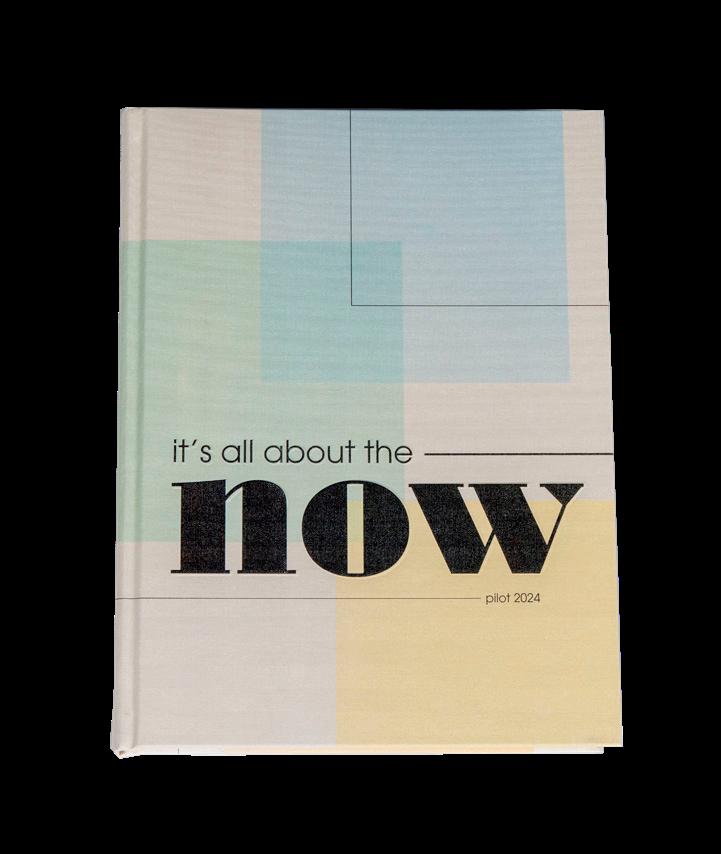

Jayla Dorbor
hether we like it or not, we all eventually feel like we’ve become our parents. It might be screaming at the TV while watching sports like your dad, or making sure everyone brings a jacket to the movies like your mother. Whatever it is, everyone gets this feeling, but why does it happen? Your parents instill these core values in you as you grow up, that can manifest themselves as a variety of different behaviors which affect your personality once you’re grown.
I am a first generation African-Indian-American. My mother immigrated from India when she was 10, and my father from Liberia when he was 17. My parents are “typical immigrants." They grew up extremely poor but worked hard to gain the life they have now. I grew up hearing so many stories of my parents struggles and how hard work was the only way out of their situation. They became role models for me to work my hardest in everything I do to make sure I can create an even better life for myself, as they did for me.
Working hard became a core value for me because my parents had shown me how effective it was from a young age. While parents cannot change your whole personality, they can convey principles that seep into your soul and stay with you for the rest of your life, whether they’re good or bad.
Though my parents have done a great job at teaching me to be determined and to focus on my goals, sometimes they can become overbearing. They can occasionally micromanage me or make me feel like I'm not doing enough to live up to their expectations. It makes me feel less confident about my abilities. If my parents constantly acted like this, I would want to give up instead of working harder like they want.
Another example of parents' beliefs affecting their children are their political views. According to a study published in the National Library of Medicine, “Children spend their formative years with their parents, who might shape ideological beliefs either directly (e.g., through political discussion) or indirectly (e.g., through modeling).” Not only can parents directly influence your political beliefs, but they can indirectly cause you to sway a certain way. For example, extremely liberal parents in California, or devout conservatives in Wyoming would most likely talk a lot about their political beliefs, especially to their kids since they want them to view the world with the same mindsets. They could also indirectly affect your political views by watching certain news channels like CNN or Fox that share news differently. It is commonly known that big life events, like graduating high school or getting married, can change your personality. However, in a
study on how your experiences shape your personality, Keely A. Dugan found smaller life events “add up over time, leading to even greater personality changes than major events.”
Small events like your parents yelling at you for getting a bad grade, or saying they're proud of you for winning a game can all shape your personality. Especially when you are younger and impressionable. These little wmoments when parents show you their beliefs will eventually affect you when you’re older.
Your parents are largely in charge of your lives from the time you're born to when you have a life of your own. The experiences and values they create for you stick, even after you leave home. These influences may be good or bad, but they will definitely affect you for the rest of your life. Next time you question why you're becoming your parents, think about the core values your parents instilled in you when you were growing up.
The High Tide encourages greater input of perspectives from both students and staff. If you have an opinion about one of the articles, letters can be sent to the editor at hightideonline@gmail.com
We reserve the right to edit for content, grammar and space constraints. Letters must be signed and are not guaranteed to be printed. Please keep letters to a maximum of 250 words. Longer guest opinions are also accepted.
by Payton Rothluebbers

Recently, I came across a video on my phone explaining a scandal with a social media influencer. It was the typical influencer scandal formula: post something racist during your childhood, try to hide it, and then cry and blame it on the way you were raised. I closed out of the video and washed my dishes, unsurprised. However, this time, my sigh of annoyance came with a side of curiosity. Is it really because of the way they were raised, or is it by choice? Is it that hard to form your own identity?
Parenting is a widely discussed and highly controversial topic. I can barely scroll through Instagram without seeing something about helicopter parenting, unschooling, gentle parenting and much more. Parents are typically very careful when formulating their parenting style, knowing that it will have a lasting effect on their kids’ lives. But parents aren’t the only factor. Kids grow up. They go to school, find and pursue their personal inter-
ests, see the world, and access the internet. Their identities are formed by much more than their parents.
When we’re babies, our parents are our best friends. In the toddler stage, maybe a sibling or a friend from daycare gets lucky enough to hold that title. But by the time we start to approach middle school and understand who we are, parents get demoted. No matter what kind of parenting style a parent takes on, whether it be incredibly controlling or more laid back, twwhey can’t prevent the fact that their kids value their peers’ opinions more than anything.
A Cambridge University Press article found that children “construct their identities in the context of the environment around them” and around the “roles of their age group.” In other words, kids don’t want to get their identities from their parents; kids want their identities from the "cool" kids in their classes. If my little cousin’s friend called him an alpha male, it would mean a lot more to him than his mom or dad telling him he’s awesome.
Whose handwriting did you steal when you were in third grade? Was it the nice, quiet, neat girl you sat next to? When you were bored, was your first thought to hop on Minecraft or Roblox with your friends or was it family game night?
Maybe you do love family game night, or maybe you stole your mom’s handwriting. However, the majority of children stray from and develop different opinions from their parents in one way or another. For example, a study conducted by Penn State found that “children have a say in determining their own political identities” and that “they are not simply carbon copies of their parents.” Children have proved over the years to hold their own beliefs, love who they want to love, and be who they want to be, despite their parents’ opinions.
But are you really going to let the skills your wwwwparents teach or the values they push onto you solely inform your identity? Influencers should be expected to be more than their parents’ racist values. What about the queer kids who express themselves despite their homophobic parents? What about the kids who can identify their parents’ racism and make better choices? What about the kids who are breaking patterns of abuse? Be yourself. You are not your parents.

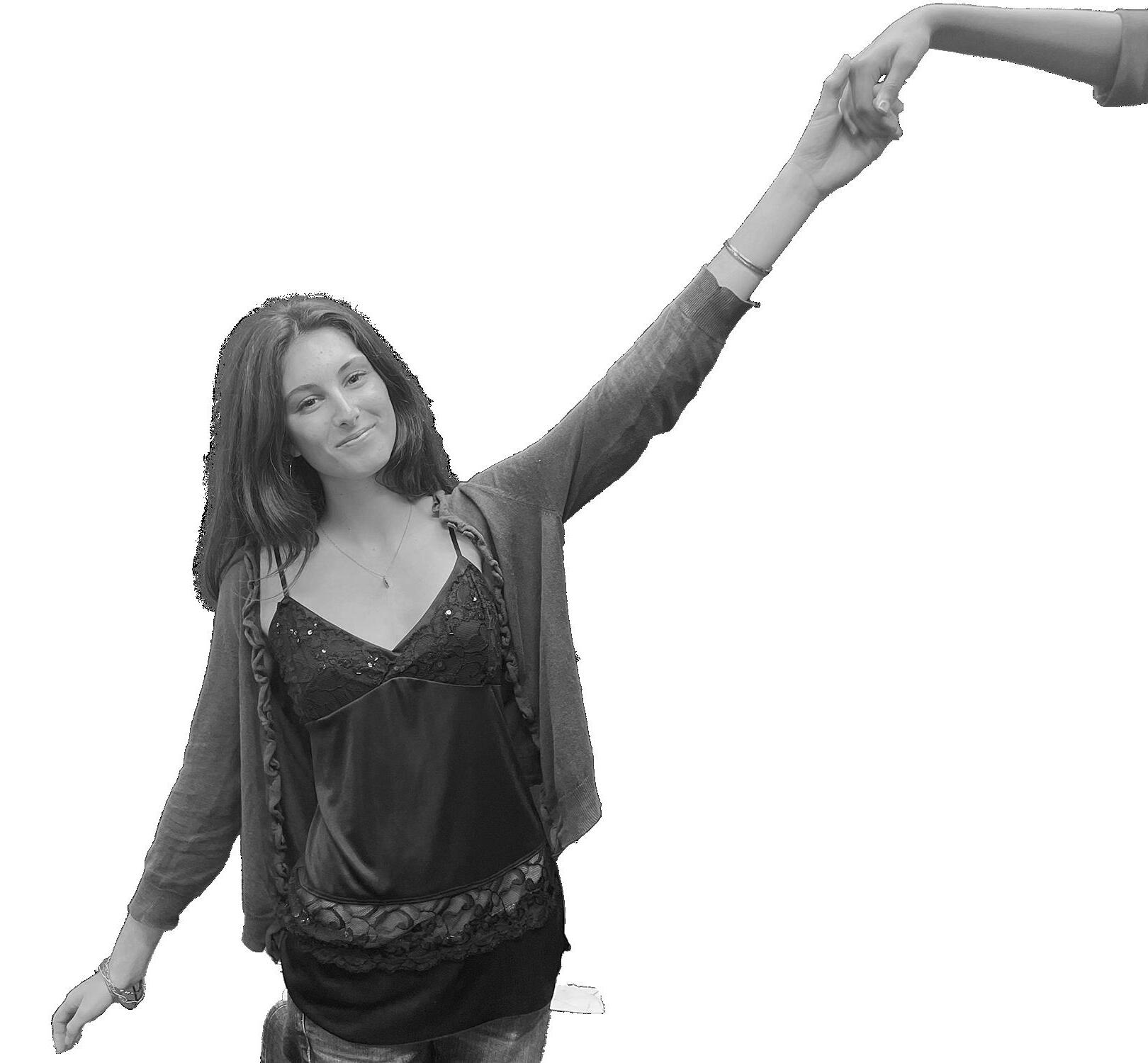

by Daniella Gross
isten—I don’t think women get to “complain” about periods enough. Still, with how far women's rights have come, surely we reserve the right to openly discuss what we experience every month more frequently. On top of being slammed with waves of demotivation, fatigue, and depression, we also have the pleasure of cramps that often leave us in fetal positions on the ground. To complete the package and wrap it up in a neat little wad of toilet paper, we also lose handfuls of blood by the hour. And yet we sit quietly in class and make due. We keep quiet and sneak away to the bathroom when we can, pray we don’t leak through our jeans and spend fortunes on products we can’t even trust.
The average woman spends around $2,000 on tampons, $45,000 on pads, and another $2,000 on ruined underwear during their 40-year span of menstruation, according to the Boston Medical Care Center. Depending on how heavy someone's flow is, each cycle has a rough estimate of $20 worth of products used. According to the Wall Street Journal, female hygiene products are rising in cost, furthering the gendered equity gap in society, but they also could potentially contain toxic earth metals. A recent study from UC Berkeley confirming the harmful contents of tampons left women and teens with a question— how can we avoid exposing ourselves to lead?
Lead, a highly toxic element, is quite talented. The Center for Disease Control and Protection (CDC) states that lead possesses the capacity to mimic the actions of calcium and can interact with proteins when entering the bloodstream, almost as if it has shapeshifting abilities. This causes multiple dangerous health risks and can affect every organ system in the body. However, lead is just the headliner and the opening acts are equally as startling. A UC Berkeley experiment conducted on tampons and their contaminants found that arsenic, cadmium, and mercury, to name a few, varied in concentrations depending on the brand of tampons and organic vs. non-organic. 30 tampons from over 14 brands were tested. All of them contained these earth metals, which means pinpointing a specific company or brand won’t get us to the root of the problem.
Medical News Today found that due to tampons' makeup of fabrics made from natural fiber cotton and/or rayon [man-
made fabric from cellulose fibers], environmental changes in soil balance can cause tampon companies some issues. Corrie Pelc from Medical News Today states, “The contamination of soil within the agricultural industry by toxic metals – such as mercu
Menstrual cycles in general are something the public tends to be uncomfortable discussing, to the point where women's safety hasn’t been considered in the long run. It is appalling that it took 9 decades to discover that lead has been in contact with women's most sensitive area of the body. So what exactly does this mean for wom-
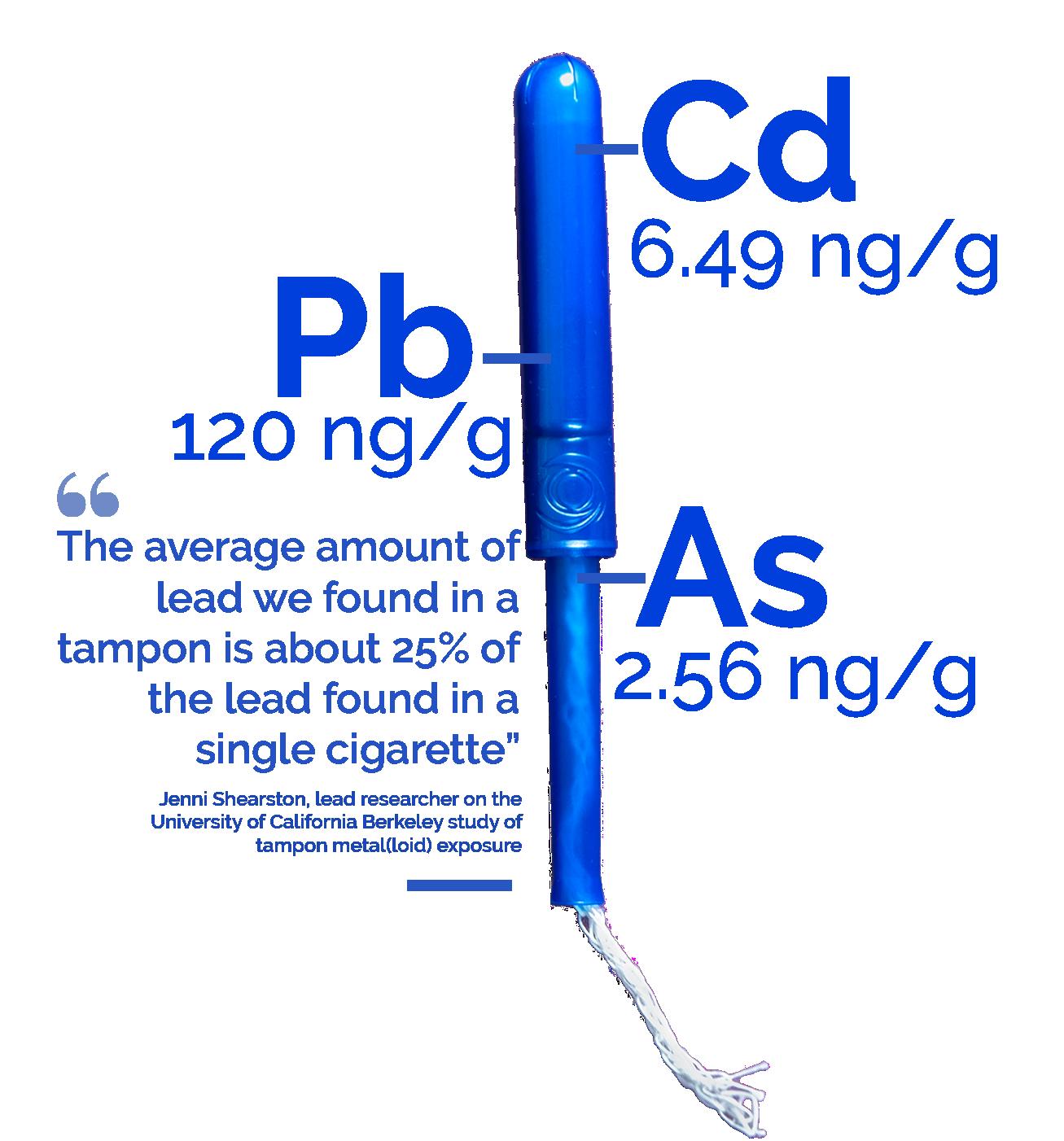
this since the tampon's big debut in 1931.
engaged in three lawsuits amounting
to one large three-year-long action class case where they were found guilty of their products containing PFAS [per- and poly-fluoroalkyl substances]. PFAS are nicknamed “forever chemicals,” and they are widely used, long-lasting chemicals, which break down very slowly over time. PFAS additionally come with their own special bundle of health risks such as changes in liver enzymes, increases in cholesterol levels, and kidney/ testicular cancer, according to the CDC.
Forty-five percent of sanitary pads and panty liners tested positive for PFAS and 65% of period underwear. These ubiquitous chemicals aren’t only found in period products, however, being present in everything from tap water to shampoo since the 1950s. Certain bans and restrictions have been put in place for the near future thankfully, but most don’t go into effect for another 15 or so years.
Safety seems to be nowhere in sight. We simply cannot hide from chemicals that have infiltrated every part of our lives–and bodies. Finding menstrual product lines that you can trust is so important to the broad range of 15 to 49-year-olds who rely on these care tools. Pushing our world further to make companies accountable for the chemicals processed in manufacturing stages is crucial, and the longer we remain impotent, the longer we face the dangerous consequences of tampons.
by High Tide Editorial Board
Redondo offers three world languages: Spanish, Chinese and French. Although our programs are robust, there are more than three world languages spoken by our students, and many would like the opportunity to practice their native language in a classroom.
For students wanting to take language classes other than what are offered here, this means enrolling in additional courses at other institutions, like El Camino College. However, this solution is not without its challenges—students need to manage additional assignments, coordinate transportation, and pay for classes. Moreover, balancing the extra coursework with their regular academic responsibilities can lead to increased stress and time constraints.
Online language courses offer another alternative, but they come with their own drawbacks. While digital learning provides flexibility in terms of scheduling and access,
it can also introduce distractions and reduce the quality of the learning experience. Online courses often lack the immersive, interactive components of face-to-face language learning, such as group discussions, speaking exercises, and cultural exchanges.
To better serve its diverse student body, Redondo could also consider expanding its language offerings to include a broader range of languages. For example, along with Chinese, Spanish and French, other schools offer more options: Mira Costa High School offers four years of American Sign Language, West High School includes Japanese and Korean, and Palos Verdes High School includes Latin and Korean. If RUHS could adopt similar, expanded world language curriculums, this initiative would not only enhance inclusivity, but cultivate a deeper sense of identity for some students.
One potential challenge of expanding language offerings is the risk of low enrollment in less commonly stud-
ied languages. Students might naturally gravitate toward more widely spoken or globally dominant languages, lowering enrollment numbers in these new classes and decreasing the school’s ability to economically sustain the classes. Also, expanding language offerings would require hiring qualified teachers who are capable of instructing in those languages, which can be difficult depending on the availability of language educators in the local area, as well as the cost of creating and planning a new four year course.
However, the value of language education prevails over the costs. Not only can this opportunity offer cognitive advantages, but it allows people from different cultures to connect meaningfully. Language education is more than just a graduation requirement—it is a means to connect to family heritage and cultural roots and would lead to a more inclusive future for all students.
"Beetlejuice
Beetlejuice" is a fun, campy throwback, but needed better finessing to reach its full potential by
Amina Raiss
Beetlejuice, Beetlejuice, B …
The sequel to the 1988 film “Beetlejuice” arrived in theaters on Sept. 6. This second installation of the classic features beloved returning characters: Micheal Keaton as Beetlejuice, Winona Ryder as Lydia Deetz and Catherine O’Hara as Delia Deetz. The new “it” actress Jenna Ortega portrays Astrid Deetz, daughter of Lydia while Monica Belluci shines as Beetlejuice's jilted ex-wife, Delores.
Directed by Tim Burton, the movie's opening scene pays homage to the 1988 original, giving us an aerial view of Winter River, an idyllic New England town dotted with traditional homes atop grass-covered rolling hills. For lovers of the classic, the Dan ny Elfman score sets the scene for more nostalgia to come.
The original movie was a mind-bending tale following the young couple, Barbara and Adam Maitland (Geena Davis and Alec Baldwin), navigating their new life as ghosts. When the Deetz’s move into their home, the cou ple, with the help of medium Lydia, try and force them out of their home. With Hallow een season proaching, the have come at Accompanied by stunning visuals, great costuming, zany characters, and a great soundtrack, I felt trans
ported to autumn in Vermont.
It is funny but, still has a few light scares to get viewers in the spooky mood.
Fast forward some 30 years later, and we are reintroduced to an adult Lydia Deetz, still black-clad and goth but now capitalizing on her ability to communicate with the dead. Lydia hosts her own paranormal TV show, Ghost House, directed by her spurious boyfriend, Rory played by Justin Theroux. Lydia, flustered mid-interview by a sighting of Keaton’s Beetlejuice, promptly leaves the set, and we get

panied by Rory, Delia and her estranged daughter, Astrid. Through a series of unfortunate events, the Deetz mother and daughter duo struggle to remedy their relationship and need to recruit the ever-entertaining Beetlejuice to remain among the living. Beetlejuice has problems of his own, fighting to avoid his soul-sucking ex until the two stories collide. Director Burton energizes the sequel by the addition of new characters and psychedelic visuals that set his work in a world of its own. It is interesting that the world of the living is portrayed as sparse, subdued and orderly. This is in direct contrast to the world of the dead, where the scenes are colorful, dynamic and imbued with energy. As well, the music in the underworld is lively and upbeat, casting the world of the dead as a place where life is actually happening.
Seeing Ryder and Keaton back on screen together was a treat, and they stayed true to their portrayals in the original. A standout for me though was O’Hara. Practically every single one of her jokes landed and I found her performance perfect for this type of movie. “Beetlejuice Beetlejuice” was not a disappointment for me or seemingly everyone else who was in Theater 11 with me. The entire room was laughing, clapping to the music, and overall enjoying themselves. It’s been a long time since I’ve been in a theater as lively as this one was.
I do think this movie could have benefitted from an extra 30 or so minutes. Almost by force, some storylines seemed thrown together and incomplete. Beetlejuice’s storyline with his disgruntled ex-wife Delores would be an interesting plot in a different movie, but here it seemed superfluous and hasty. Given that this sequel is long-awaited, I understand
the motivation of the filmmakers to give the audience a “big” story. Instead, the awesome Ortega and Ryder were underutilized and Beetlejuice didn’t have as much screen time as he deserved. Ultimately, the film was campy and feelgood, with some light scares and a perfect spooky ambiance. While I don’t prefer it to the original, the sequel does check the necessary boxes: it is funny, silly, quirky, and pure escapism. I sat in the theater for 90 minutes and never once thought about my homework, college applications, or my upcoming tennis match. While certainly not Oscar-caliber, you will leave the theater with a pep in your step.
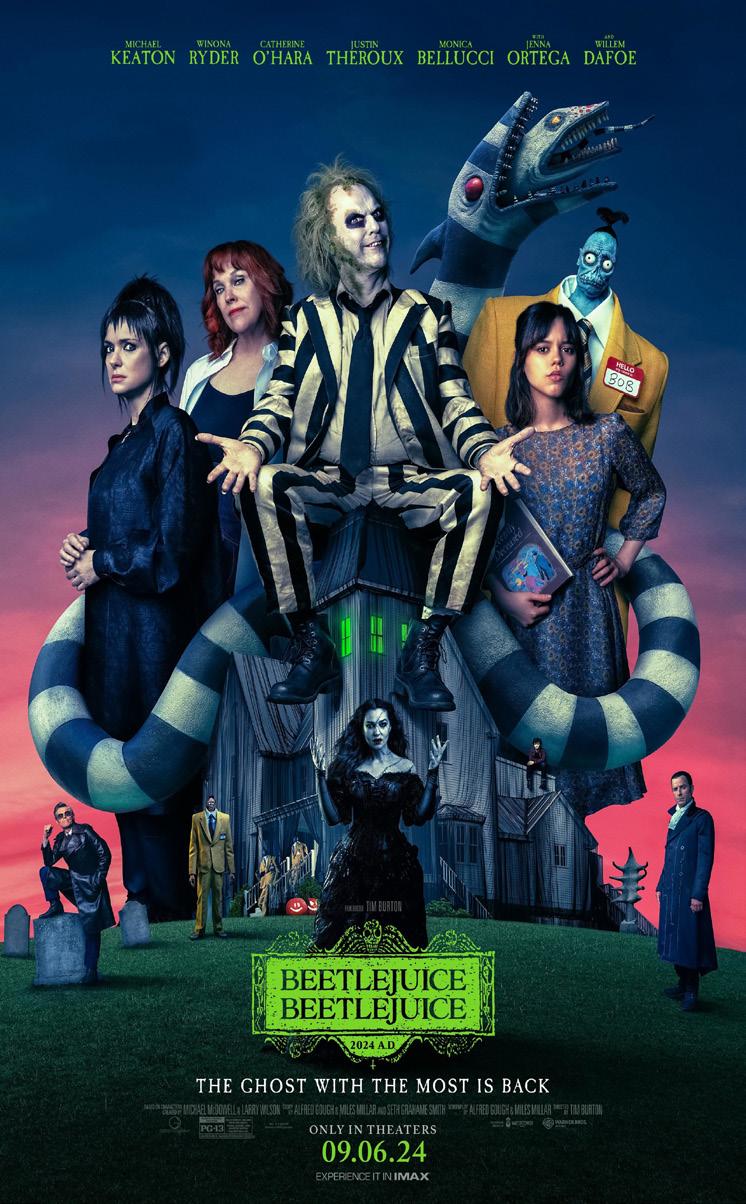
"Alien: Romulus" is a dynamic, cinematic thriller with storytelling that offers a satisfying continuation to the long time franchise by Aaliyah Roberson
As an avid fan of action packed plots and slow-building romances, I am extremely grateful I pushed myself out of my comfort zone to experience the panic inducing sci-fi horror known as “Alien: Romulus.” After its release on Aug. 16, I genuinely had no desire to travel to the cinema and watch it, most notably because it would’ve been a waste of time and money as my eyes would be squeezed closed and ears plugged. However, after the film crossed $300 million in the box office after its release less than four weeks ago, I just had to see what the hype was about. As a newcomer to the franchise, I was pleasantly surprised by the themat-

ic masterpiece director and co-writer Fede Álvarez was able to produce as I was teleported into a world of amazingly terrible aliens.
The story of Romulus, set between the events of the previous films Alien (1979) and Aliens (1986), begins with a journey to a ruthless star mining colony owned by Weyland-Yutani. There we meet Rain (Cailee Spaeny), a struggling girl trying to finish her contract and escape to the hopeful city of Yvaga. Feeling trapped and helpless after being condemned to more years working in the dreadful mines responsible for her parents' deaths, Rain takes her malfunctioning synthetic android brother Andy (David Jonsson) to meet with a group of four fellow young space colonizers, who have a proposal to abscond from their dreadful situation and gain their freedom from a life of servitude. In an effort to escape their backwater planet full of slavery and decay, the crew soon realizes the reason why a station with such valuable gear has been left behind: a murderous alien life form known as the xenomorph.
Immediately, I was entranced in the film as the storytelling was laid out beautifully by depicting a ruinous world where people must do extreme things in order to survive. The cinematography truly stood out for me throughout the course of the story. As a film nerd, right after I left the theater I found out that they used an Alexa 35 camera with master primes lenses (a call back to the first Alien film), which also allowed for a flexible range of camera work and distortion. There was a distinct shift from the wider perspectives at the beginning of the film to exclusively tight closeups towards
the end, most prominent when the final alien was wreaking havoc on the remaining crew: the camera was close enough to see glistening sweat and tears of desperation. In the station, there were numerous first person shots where it felt like a video gameonly adding to the immersive effect of its dynamic editing.
I have a soft spot for sci-fi films such as "Interstellar" and "Star Wars," both of which played a vital role in my creative upbringing and my dream of being a filmmaker myself. One of the main successes of both of these stories were their iconic characters who touched the emotional wellbeing of the audience through simply a screen. While watching “Alien: Romulus,” I found the casting of characters and their performance a highlight throughout. I found every role and backstory developed thoroughly to create the key relationship dynamics of a working team in such a brief amount of time that it made the film even more realistic in its storytelling.
Another great factor to this movie was its use of special effects throughout. I was very surprised by the scale of this film in terms of using the
environment of space. A beautiful world was created by the abandoned station surrounded by what resembles Saturn’s rings, especially when there were many major disasters presented such as an out of control ship and the impending doom of incoming turbulence. While it was truly disgusting to witness, I thoroughly enjoyed the use of special effects to heighten the amount of gore as the aliens burst through bodies and inflict pain.
While “Alien: Romulus" was merely the newest installment of a long running franchise, it created its own story that deferred from the rest using its relationship building and cinematic production to recreate the world in an even more thrilling way. I believe these factors made my decision to ignore my original prejudices against horror films worth it and encourage others to do so, as well.
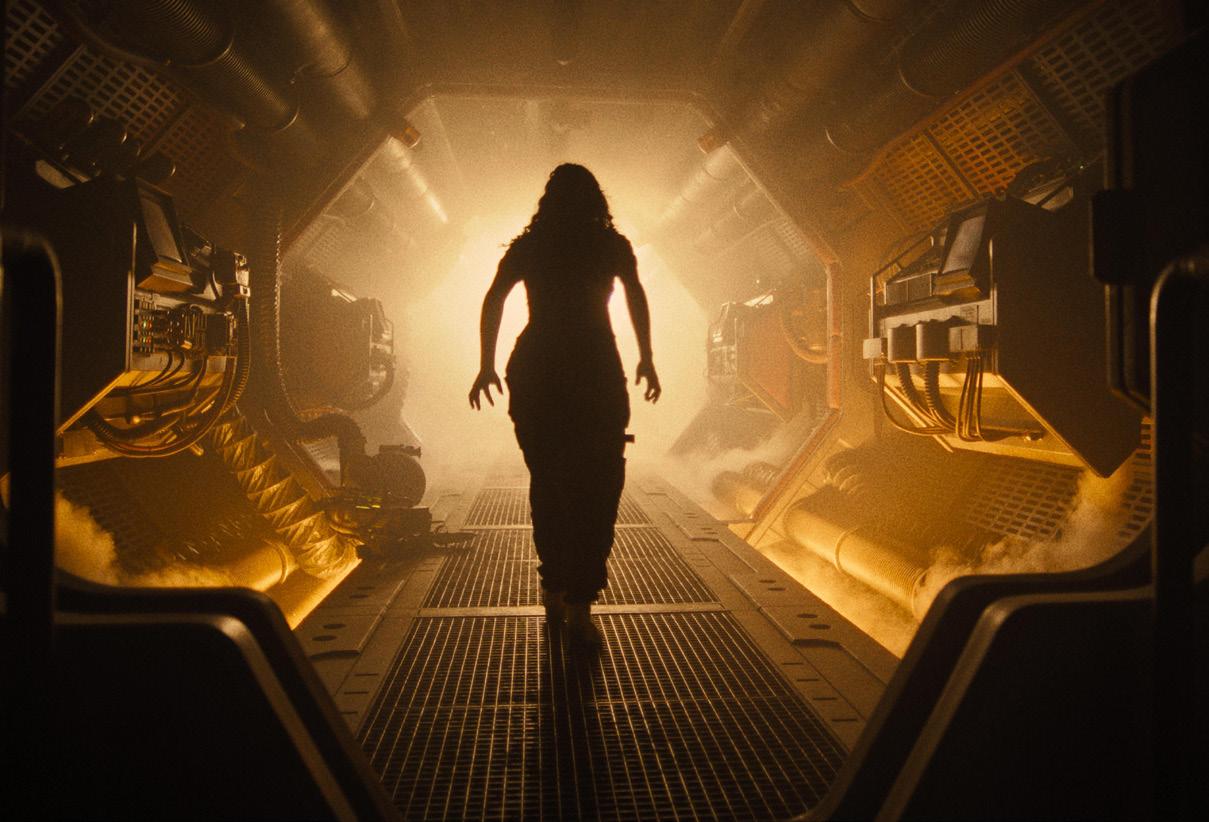
by Kat Otey
Gentrification: a complicated and often depressing topic. Frankly, what even is gentrification? It feels like a catch-all complaint that gets thrown around, like the liberal version of the phrase “political correctness.” Do you even want to read an article about gentrification? Probably not. That’s why I’m blatantly catering to readers by addressing the topic under the guise of two slightly cynical and hopefully approachable cafe reviews.
Since you should never get your news or opinions from just one source, I would like to preemptively encourage you to do further research than this article. A simple “what is gentrification” into your chosen search engine will even do.
n It goes like this: "Generic Neighborhood A" catches the eye of the competitive housing market and aggressive large corporations, who move in and price out anyone who doewsnt work for them or is too wealthy to work for all the artists, small business owners, and all of the other interesting people. These people move into "Generic Neighborhood B," which is traditionally a working class community often inhabited by minorities, racial or otherwise. The newcomers mean no harm when they reopen their coffee shops in
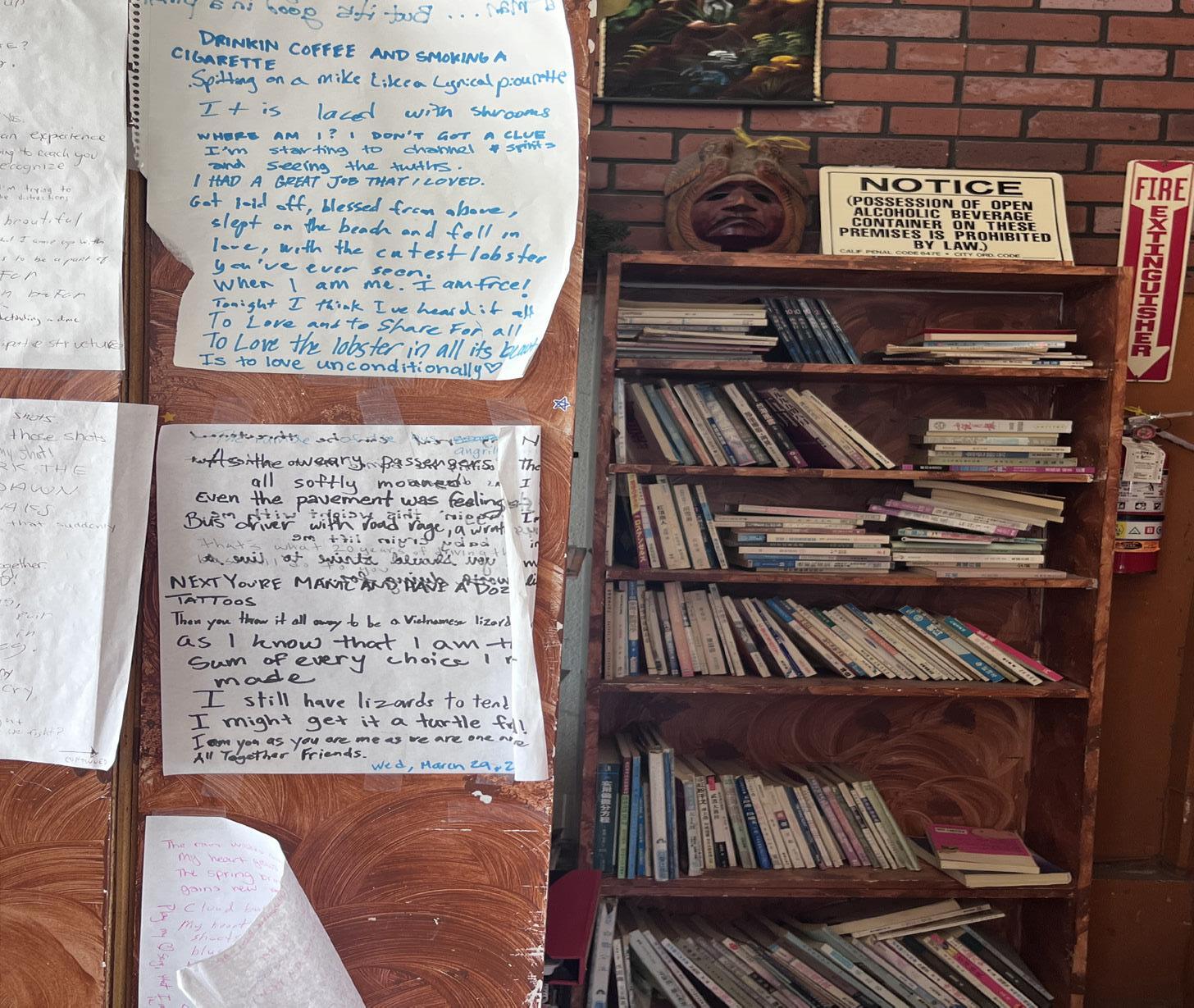

Eventually, enough marketable experiences and business ventures will open that the area will attract investors, house flippers, and people who still think gray and glass is an exciting combination for a building, and these small businesses are priced out all over again. And thus the wcycle continues.
That said, cafes do have genuine significance in the discussion about gentrification. Grand openings of “specialty coffee houses” are said to be the first warning sign that a working-class neighborhood is about to get a) pricey and b) a makeover. Bar maybe SoHo, New York, Southern California is pretty much ground zero for gentrification.
Here, I rank a few examples by three standards: price, aesthetics and how out of place I would feel walking in like a normal, un-Instagramable person, with greasy hair and old clothes and all.
Although I didn’t wake up early enough for Senior Sunrise (I set realistic expectations for myself), I did make my way down to Lavender & Honey on Monday morning.
The first thing you will notice about Lavender & Honey is that it is very white. The outside is a summery cream, the inside more stark and printer-paper-esque. It vaguely reminds me of my house right before relatives come over. Clean and aesthetically pleasing, sure, but also still and sterilized—leading me to flee back to my own room with all its peeling posters and haphazardly stacked knickknacks.
Lavender & Honey is only a three-minute walk from my house. It’s also relatively new- opening just earlier this year to weeks of packed tables. But before that, it
was your dime-a-dozen drug store, fitting in better with the constant noisy, angry traffic of the street it sat on. On Monday, I walked there for a small lemonade and a croissant—no matter how tired I was, I frankly just wasn’t paying seven dollars for aesthetically flavored coffee. But this same time last fall, I could buy my sister and me two of objectively the best ice cream sandwiches in a fifty-mile radius and an energy drink for the same seven dollars. Maximum.
That’s why I do have to give Lavender & Honey at least a four out of five on the gentrification scale—I literally watched the gentrification happen. The prices (category one): high. And yes, I’m aware that they’re higher because I’m paying for organic or fresh baked or vegan products, instead of whatever chemicals I didn’t pay enough attention to in chemistry to pronounce, that are in a Monster, but that’s a different discussion.
Categories two and three bump up the score even more. I’ve mentioned the whiteness, and the intimidating menu wall that imitates a handwritten chalkboard— only the writing is a touch too uniformly flourished to be anything but typed.
Standing in line, you are also surrounded by a multitude of brightly wrapped additional products: the only pops of color in the cafe, monetized and advertised for those who can afford to pay their way to politi-
cal correctness. Not that I was counting, but I think I saw the word “organic” twenty thousand times during my brief wait. Additionally, in reference to category three, I felt appropriately dressed only because it was a Monday (before I’ve lost the energy to care about my appearance for the week), and the color palette of white and beige blended me right into the booth I sat in.
Several chai tea lattes were ordered. LuluLemon pants hurried in and then out again (I think it’s interesting how wearing LuluLemon gives people the impression that they have to be in a hurry all the time). My favorite customers of my people-watching session were a trio of women wearing matching bright blue and pink shirts that said “Chevron Fuels Genocide.”
Although the experience was pleasant, the “specialty coffee house” energy of Lavender & Honey is unfortunately apparent.
Listen. All this makes me sound like some sort of weirdo who doesn’t enjoy getting coffee and spending the afternoon studying with my friends. Luckily, I get to tell you that isn’t true: and if I have the choice, I’ll choose Coffee Cartel. It’s a little darker, but it fits in a little better with its surroundings. Much unlike the often homogeneous crowd at more aesthetic-focused locations, I sat between two very different pairs. On
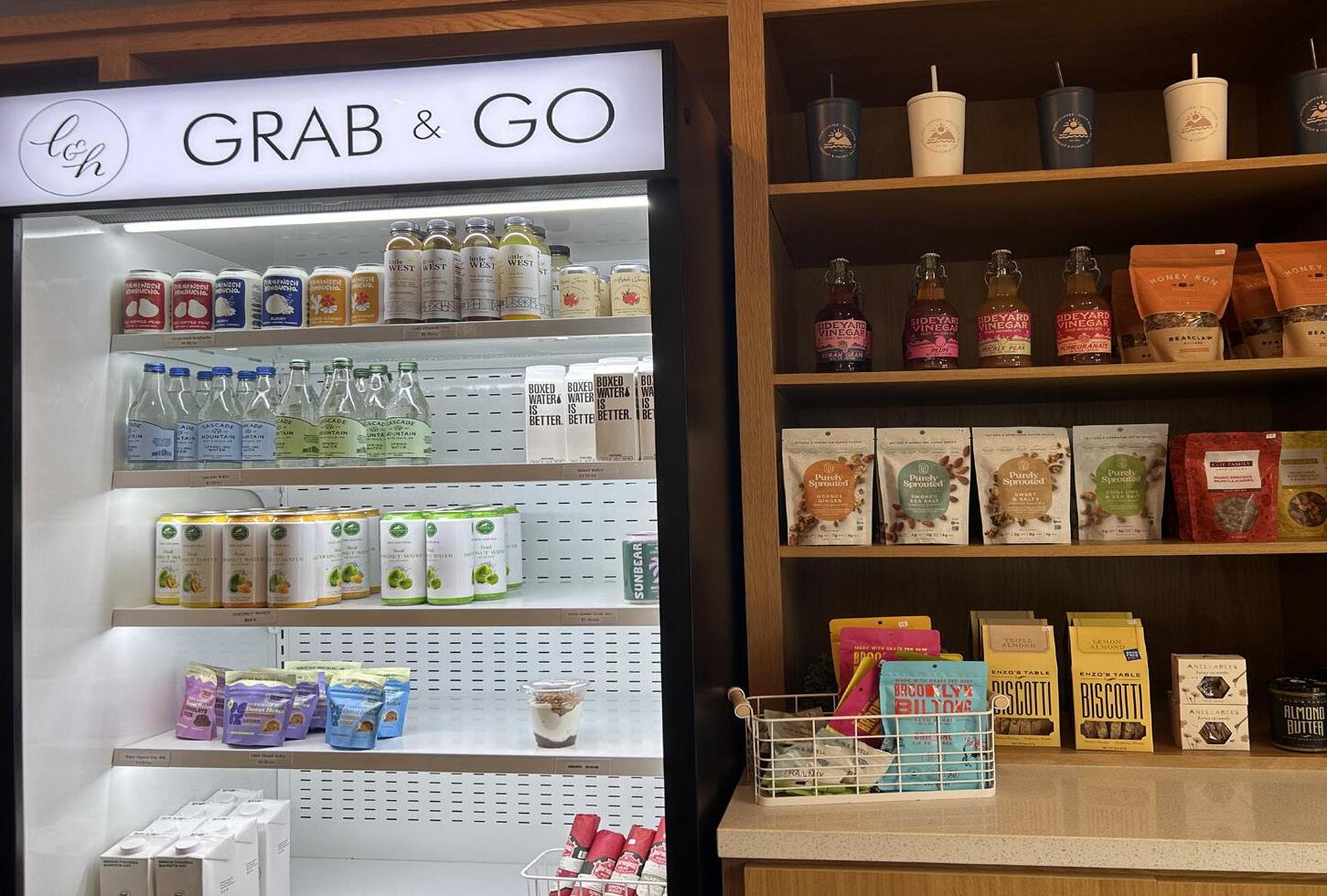
my right, a middle-aged man and woman seriously analyzing the weathered books with cracked spines, plates long empty. On my left, two teenage girls drinking iced lattes and discussing whether the girl one of them has been texting is a lesbian or trying to recruit her to a religious cult. Coffee Cartel has more accessible hours, too, staying open into the evening instead of closing at 3, which alienates not only students but anyone who works regular hours at least five days a week.
The prices are fairly middle of the road, although I did get my after-school snack muffin for three dollars- the food, at least, is relatively cheap. From the counter, you can see boxes of energy drinks and coffee grounds stacked together against the wall. Returning to the analogy of my house the day before relatives arrive, it feels more like walking back into my room- relaxing and familiar.
Instead of flashy, expensive products neatly lined up on shelves, the space next to the checkout counter is used as a pinboard of sorts for advertising local businesses or even individuals: flyers for spanish tutors, calls for halloween festival volunteers, an invitation for a wine tasting that is raising money for first grade classrooms, and many more piled on top of one another haphazardly. There are faded, handwritten letters taped to the walls, and the day I went there was a bowl of handmade bracelets labeled ‘free.’ Bookshelves up against the left wall are filled with secondhand books, labeled one or two dollars each
Instead of looking like they were just passing through or only there to take Instagram photos, the people at Coffee Cartel come and go as a part of the community within its four walls. It’s a small business that feels like a small business, not the cafe equivalent of an industry plant.
I would give it only one out of five stars- Coffee Cartel truly represents the idea that for something to truly mean something it has to be a little dirty, and a little imperfect.
Although this article is mainly about jokes, personal preferences, and a lighthearted approach to make a daunting topic more approachable, gentrification is a very real and complex issue that I truly recommend looking into.
Read another article. Watch a video essay. At least listen to “All I See Is Wagamama” by Beans on Toast if you can stomach explanative but catchy folk punk for five minutes and forty seconds.
Additionally, I will note that all of the above options, regardless of their faults, are a far better and at least slightly cheaper option than corporate chains like Starbucks.
While an aesthetic cofhouse popping up may be a warning of spiking prices in your area, the appearance of a Starbucks is, like, THE sign that you’ve been gentrified. And I’d far prefer to sit in the midst of a crowd of mostly pleasant organic chai drinkers than be stampeded by entitled, fussy ten-dollar pumpkin spice enthusiasts.
So really, all of this is to say that if you’re craving a study space with snacks, it is always better to choose local options than corporate ones—but also to keep a little bit of cynicism on hand wherever you go to consume in the first place.

Coming off a four game winning streak, girls varsity flag football continued to show their dominance on the field with a sweeping victory against Narbonne on Tuesday, Sept. 17 non-league game. Winning 47-0, the Sea Hawks defense acted as a “perfect brick wall,” according to sophomore safety Riley Durepo, who helped prevent the team’s opponents from getting anywhere near the end zone for the entire 48 minute game.
“I played rusher during the second half, which I’ve never done before. It was a fun experience, and I got a lot of pulls,” Durepo said. “Defense has to make a lot of split second decisions, since each play takes such a short amount of time and you can’t wait too long. When you play rusher, you have to [quickly] make the right call on who’s going to get the ball, and if it’s going to be long or not, or you’ll miss the action.”
The team’s win seemed likely early on, with a commanding 33-0 lead by halftime. Senior and offensive captain Hailey Gavin-Wenches had scored the first touchdown within the first five minutes of the match, setting the tone for
“We've never played [Narbonne] before, so we were really excited to get out there and prove ourselves to a new school,” Gavin-Wenches said. “The key to doing well is confidence, and for me, I think doing so many training camps over the summer really helped improve my confidence and my coach’s trust in me going into this season.”
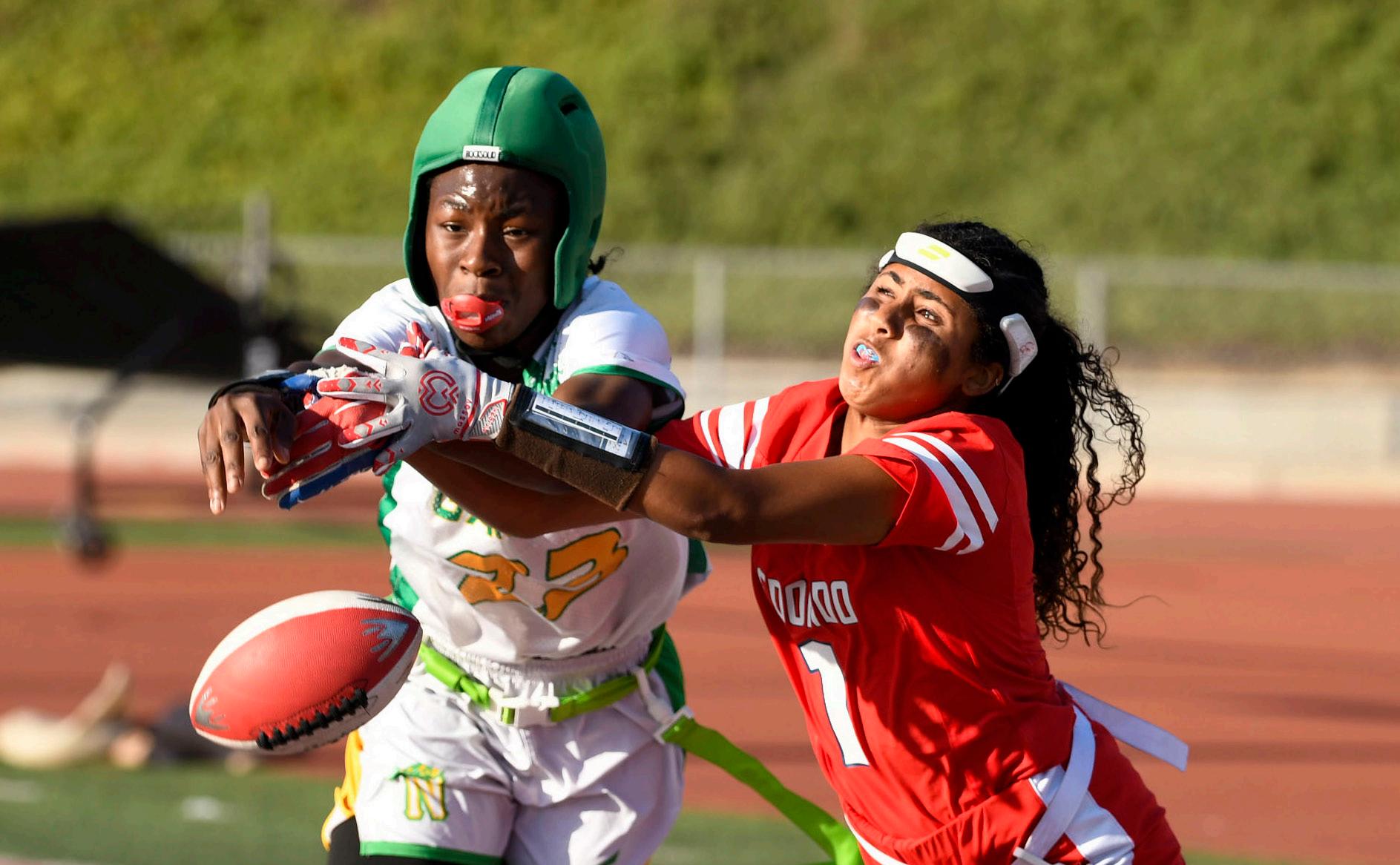
The second half slowed down a bit, as the team used the cushioning of their early lead to experiment with lineups, switching out quarterbacks and allowing players like Durepo to try different defensive positions. These adjustments were possible due to the team’s strict training schedules in which the girls hone a variety of skills to become as versatile as possible by game day.
“Practice is around two hours long, Monday through Friday, and we work on everything from weights to speed training," Durepo said. “A lot of us are also in other sports, for example, I’m in soccer and track and field as well as flag football, which really helps me improve our overall athleticism.”
To make the victory even sweeter, cheering on the Sea Hawks and later joining them on the field for a celebration were the young girls from Girls Beach Cities Sports (GBCS), a youth group of flag-footballers whom Durepo hopes to see "continue with the sport and join the RUHS program one day."
“Them being in the stands really moti-
vated us to do better because we wanted to inspire them to eventually join this team,” Durepo said. “It’s great that they're starting at such a young age, and having young girls look up to us is a really awesome feeling.”
Since their victory over Narbonne, the varsity girls have bested their rivals at Peninsula and scored their largest point gap yet in a 74-0 match over Whitney. They aim to continue their undefeated winning streak for the rest of the season, and will face Mira Costa today at 6 p.m.
“Having so many games and practices close together can be a little physically tiring,” Gavin-Wenches said. “But I feel like if we just keep up the same mentality we came into the Narbonne game with, we’ll be able to avoid burnout and continue to show the other schools why we’re the best in the league.”
Girls volleyball fought a difficult, but victorious battle against South High
by Delilah Aguilar
Easy sweeps and quick recoveries led the varsity girls volleyball team to a near-seamless victory.
On Sept. 12, the Sea Hawks stood off against South High, winning the match in straight sets, 3-0, sending the Flock home early. This marked the 14th game of their season, bringing them to an 11-3 standing.
The first two sets were quick wins for Redondo with amazing saves and scores from sophomore Shewa Adefemiwa, juniors Taylor Boice and Abby Zimmerman, and twins, juniors Addison and Avery Junk.
“As a team, our highlight was in the middle of the second set when everything was flowing, we were running our middles almost every ball, because our passing was smooth, and our serves were great,” Addison Junk said.
The team's energy was high the whole game; the bench was synchronizing cheers for their players and got the stands cheering alongside them. During each substitution, the players would make a point to high-five the whole bench before going in and out of the game.
“Our bench is amazing. We can always count on them to cheer us on while on the court. We feel their energy, which helps lift us up when we win games,” Zimmerman said.
The team was extremely welcoming to-
wards fellow players while they came on and off the court.
“Coach Tommy calls the girls who come off the bench ‘game changers’ because they come in and make a real difference during the game. It’s difficult to come in after sitting for two sets,” Addison Junk said. “Despite this, [we] always come in strong and help secure a win. This game, (senior) Jamie Deines, (freshman) Makaela Munzon, and (junior) Ashley Resendez came off the bench and made a difference.”

The game was described as a “gritty win,” according to Zimmerman, due to the struggle and perseverance of the team during the last set. South High had a surge of energy and the two teams remained neck and neck up until the final moments. Adefemiwa hit several powerful kills throughout the game, but after scoring her last point, she fell to the ground in pain. The crowd went silent, awaiting a verdict as her family and team medics removed her from the court. Later, Adefemiwa returned to support her team
from the bench for the remainder of the game.
“As a team, we hit a low during the next five points after Shewa got hurt, everyone was rattled but we recovered relatively fast,” Addison Junk said.
Fortunately, according to Addison Junk, medics do not believe Adefemiwa’s injury was anything serious. She most likely sprained her knee, which she will be visiting a second doctor to confirm.
“We’ve only lost three games this sea-
son in Hawaii but apart from that, we’ve been doing so well and secured the No. 2 ranked team in California,” Avery Junk said.
“We did an amazing job staying in the game, and even when we fell back towards the end, we managed to come back from it stronger which will only help us in the future.”
by Ava Anzivino
Coming off a devastating loss to Mira Costa on the road, the boys' football team returned home for their third game of the season against Huntington Beach on Sept. 13. Channeling the vivacity emanating from the stands and fueled by the desire for redemption, the Sea Hawks secured their second win of the season with an impressive score of 21-0.
In the season prior, Redondo had fallen short to Huntington by a mere point, 13-12. With that loss in mind, the team came in with explicit intentions to shut Huntington out.
“Our mindset was to not leave it up to a two-point conversion. I think last year the defense was coming in, but obviously, they couldn't do everything for us, so we knew that on offense we had to pick it up. We were going to make it a clear win, and that’s what we went on and did,” senior offensive guard Ernez Crayton said.
Huntington is led by sophomore fourstar quarterback Brady Edmunds, ranked second in the nation, an intimidating title to oppose. However, in the week’s prepa ration for the game, the Sea Hawks became familiar with Edmunds’ gameplay to un derstand how to best counteract it.
“Defensively, we prepared very well for their team. Obviously they’re very strong on offense, they’ve got a highly ranked quarterback and average 50 points a game, so we had to practice much more on de fense,” junior defensive lineman Mikey Ricardo said. “We studied his tendencies, we made sure to know who his favorite re ceivers were. We practiced containing the quarterback, he’s big and he likes to run, so we made sure he couldn’t scramble away from us.”
mance for the rest of the night.
“That first touchdown was probably the biggest one. On our first drive, we had a little fumble, but after that, we got down to the goal line, it was fourth and goal. [Ausmus] and [London] made that connection to give us the seven-point lead and that really shifted the momentum for the entire game,” Ricardo said.
According to Crayton, while the team was already “hungry” for the win, the first touchdown drive instilled a confidence in them that would help them
mental injury after a clash of players took him to the ground while Hungtinton had possession of the ball. The game paused for approximately 30 minutes before gameplay resumed, as trainers and Huntington coaches deliberated on the field, awaiting for the arrival of an ambulance to tend to the player.
“We prayed for him. That’s obviously so hard to go through, so we just have to hope that God gets him right,” Crayton said. “We knew that Huntington was going to try to take it to another level because unfortunately their guy got injured. But we all already knew, fromter what happened, we weren’t going to stop. We hading. The break didn’t hurt our momentum at -
Going into the second half, the Hawks stayed hot on offense, securing a third and final touchdown through a hand-off to Ausmus at the one yard line, leaving the score at 21-0.
“To be honest, it felt normal at that point. I mean at the end of the day, it was God’s will but we kind of knew it was going to go our way. We just kept trying to stack [the points] up, and that’s what we did,” Crayton said.

Swaying the momentum in their favor early on, Redondo swiftly scored a touchdown with a pass connection from senior quarterback Niko London to junior wide receiver Bo Ausmus, setting the tone for what would be a strong offensive perfor-
by Ethan Chi

ACrayton said.
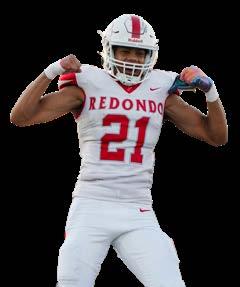
Entering the second quarter with that seven point lead, the Sea Hawks were on a roll and planned for it to remain that way. The game then took a turn for the worse with 6:30 minutes left in the half, as a Huntington linebacker sustained a detri-
fter racking up three consecutive wins, boys water polo went into last week's game against South High determined to defend their record. The Sea Hawks dove into their home pool on Monday, Sept. 16, with Redondo drowning the Spartans on offense and refusing to let up defensively. Unphased by South’s rough gameplay, Redondo’s clear control of the match resulted in a 21-1 blowout, bumping their overall record to 12-5.
Within the first two minutes of the game, the boys established a 3-point lead against South High. However, after a shot clock turnover, the boys gave up possession. Now on the attack, South wingers traveled dangerously into Sea Hawk territory, eventually scoring their first and only goal. Nevertheless, Redondo was quick on the counter, doubling their initial lead to six points in retaliation. For sophomore left winger Will Henderickson, Redondo’s dominant offense was clearly shown in the first half.
“They like to double team a lot, so we had to show that we had shooters and that we're not a one-player team. We showed them that we could score from all sides of the pool, at any point, and anything they gave us, we would take advantage of. And we showed them it doesn't matter what you do, we're going to find a way to score and get past any defense you give us,” Henderickson said.
Redondo entered the second quarter with a sizable 12-1 lead and maintained the same speed and mobility throughout the half. The boys racked up 4 more points by capitalizing on South’s stagnant defense

The tail end of the game soon became a showcase of Redondo’s defense, who, according to Crayton, has “put themselves on the map” as they managed to triumph over one of the nation’s best quarterbacks in a blow-out game. The Sea Hawk defense held down the fort for the remainder of the third quarter and the fourth quarter in its entirety, earning the redemption win they craved that week in practice.
ter that delay,aged to further their lead, 13-0, -
nior wide receiver/defensive back Cadence Turner, who ran the ball for 20 yards into the left corner of the endzone. This would close off thesizes that, while they were leading, the team did not want a repeat of last week’s game.
“Everyone knows what happened at Mira Costa the week before, we had a 13-0 lead and it didn’t end up being enough. The same thing happened here, going into halftime with a 13-0 lead, so we all had to stay focused and locked in to get the win,” Ricardo said.
“Huntington’s energy was dead after halftime, and we had the advantage obviously, so we could just tell that their team didn’t want to be there. We just made sure to keep our foot on their necks so there was no chance of a comeback. We did hear after the game that their sideline was really out of it after halftime, they were saying they just wanted to go home, so that contributed,” Ricardo said.
The Sea Hawks will play Banning at home this Friday, hoping to close off their pre-league games with a win. Victory against Huntington was a “confidence booster” that would “light a fire” under Redondo for the rest of the season, Ricardo notes.
“This was probably one of our best games, if not the best game in terms of our running offense, Ethan Maleman had over 100 yards, our whole line was dominating the whole game and they couldn’t stop the run at all defensively,” Ricardo said. “We just have to stay focused in practice and keep on the same track and we should be well prepared for what’s to come.”
and the numerous penalty shots given. Senior Carter Cole was one of many players to score. He explained the impact scoring has on the team's confidence.
“It felt really good to score, especially in front of your home court, because a lot of fans cheer for you, and you feel uplifted by your entire team,” Cole said. “I think the morale translates well, because when the whole team is positive, we start being more creative and thinking outside the box, and I think that leads to more goal chances and scoring more goals.”
Moving into the second half, the boys shut out South High’s offense, leaving Redondo’s goal untouched. Starting in the third quarter, Redondo got the jump on the Spartans, driving down their pool for a quick goal, which set the tone for the rest of the half.
However, in the bottom of the third, the Spartans finally caught a break, gaining possession after a failed Redondo attack. Due to Redondo’s blanketing coverage, South was unable to get a clear shot at Redondo’s goal resulting in a missed attempt.
The clearly fatigued Spartans just couldn’t
to Hendrickson, maintaining this substantial lead against South High bolstered the boy's confidence and proved their strength as a team.
“That's every team's dream, especially at home, to shut out a team keeping it to one goal the entire game. There's nothing else quite like it,” Hendrickson said. “We owe it a lot to our coach. He kept us focused the entire game. He didn't let us get boastful. He didn't let us start, you know, messing around just because we're beating this team, which is the only thing you can do in this situation, especially at home. We gotta show out. We gotta show what we're made of.”
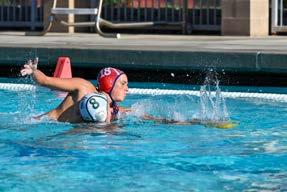
Redondo guarded their 17-1 lead by being quick on defense, always guarding South shooters, and blocking potential attacks.
“I think blocking a shot is better than scoring a goal, personally, because it motivates the team and brings momentum on the offensive side of the ball,” Cole said. “We had been working on our defense, so we were excited to showcase what we learned in practice and to use it in a game against a team like South.”
keep up according to Hendrickson.
“We did a lights-out press for the entire game. No matter how much we got up. We never sat down on defense, we never gave up on our press,” Henderickson said.
“And it honestly demoralized them a little bit, they were just getting tired, and we were getting up on every single play, which helped.”
The boys wrapped up the bottom of the second half with a final buzzer-beating goal, resulting in a final score of 21-1. According
For junior Dylan Beizerman, Heading into their next few games, the boys aim to keep the same strength shown in this game against South.
“We were able to prove ourselves in this game, and that we are capable of being great all around, but going into our next match we want to focus on the same things, like staying motivated and being first to every ball even when we are ahead,” Beizerman said. “Our team is up right now, and we want it to stay that way.”
High school students' core values are constantly shifting as they grow into each grade level. Upon coming closer to graduation, they feel more connected to the communities in which they matured
by Deeksha Prasad
The values that an individual lives by are a core part of their personality. These values aren’t their nature; however, they are learned through their life experiences.
Senior Bella Martinez felt that the morals she was taught at a young age couldn’t always be applied in real-world situations, which allowed her to develop her own set of values.
“The golden rule was to treat everybody with respect, treat everybody the way you want to be treated,” Martinez said. “But as I [matured], there were certain instances where, if I felt disrespected or used, I realized I can’t give the person [who treated me that way] that kind of respect, nor do they deserve it from me.”
Licensed Clinical Psychologist, Dr. Irma Maldonado Enriquez, says that we see value shifts in high schoolers due to “experience and exposure.”
“[Impactful experiences include] everything in their life—what their experience is with their parents, what experiences they have with their peers, etc. These are natural changes, part of development. We start to shift our world view, but the way it shifts
ident Ian Son has felt the pressure to be perceived a certain way due to his position in ASB.
Son joined ASB when he was in fourth grade. His motivation for joining lay in the fact that he always viewed himself as a “leader,” and ASB gave him an opportunity to showcase that skill. He also felt that he “struggled with confidence issues” when he was younger, and ASB helped him grow more comfortable expressing himself.
“As I was [becoming more extraverted] there were also a lot of negative influences which made me think, oh, I need to be even more popular,” Son said. “I need to know more people, especially because of elections every year, right?”
According to Son, in the past, he would attempt to fake his personality and be “someone [he] wasn’t” in order to be more likeable.
“Sometimes, when I saw people on social media who were popular, and hanging out in these big groups and having fun, it made me jealous. I wanted to be like those people, and it made me act in a different way than I am,” Son said.
Dr. Enriquez said that the way popular
ed from it,” Dr. Enriquez said.
As the ASB elections approached, Son said he felt the need to be as social as possible, and that line of thinking made election season “super stressful.”
“I was thinking, please, if I could just win this one election,” Son said. “If I could just be popular and everyone would like me, that's all I need.”
But, Son reflected, the fulfillment he felt even after winning an election was “temporary.” The experience made him realize that being popular wasn’t “everything” to him.
“I realized, what’s the point if people like me for someone that I’m not? I’d rather have everyone dislike me, and have one person like me for who I am, than have everyone like me for someone that I’m not,” Son said.
Both Son and Lily agree, however, that students tend to crave acceptance from their classmates. Students then become extremely susceptible to peer pressure, and because of that, without a strong will, their values can be shifted significantly.
“I knew this girl from middle school— we used to play ‘Bed Wars’ together. The
to her personality] are all from her influences; because when we were playing ‘Bed Wars’ in middle school, she was talking about becoming a lawyer. Now, she doesn’t see herself progressing much, or even getting out of high school.”
Teenagers have a difficult time being their authentic selves, according to Dr. Enriquez. They’re “learning as they live,” and part of that includes making wrong choices, and getting involved in wrong groups at times.
“Taking time to really get in tune with their true self, what they truly believe in that moment, can be a little scary for teenagers. Because the reality is they fear rejection. Being a part of a group is really important developmentally at that age, and, let’s be honest, for the rest of your life, feeling as if you belong is important,” Dr. Enriquez said. “So if you have a weak ego, your authenticity is going to shift depending on the group you’re with, but if you have a secure base in who you are and your values, you’re going to be pretty unwavering.”
Son believes that the “chase for popularity” is something that continues through-
